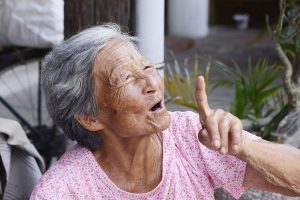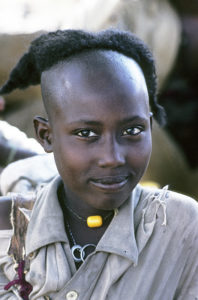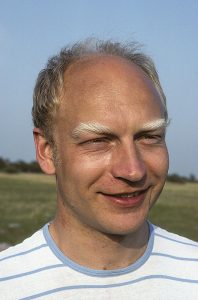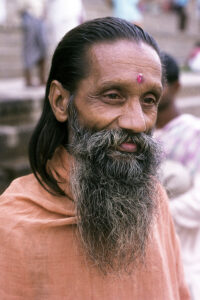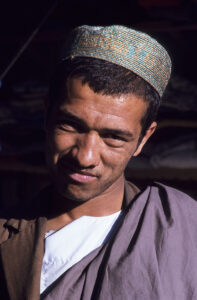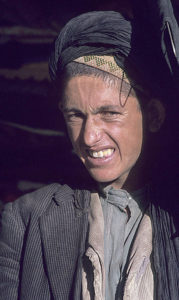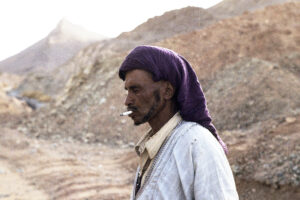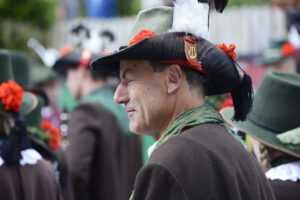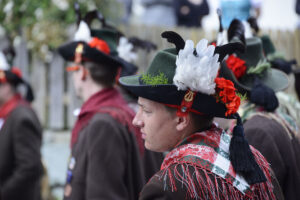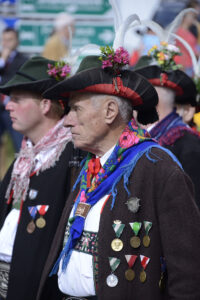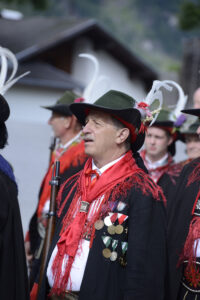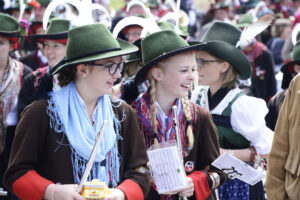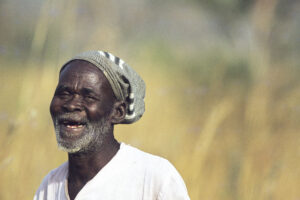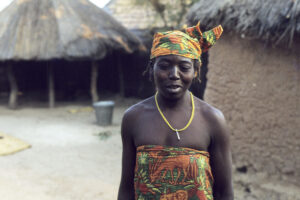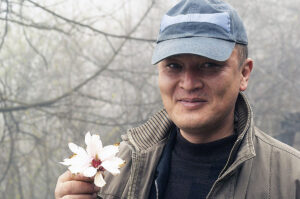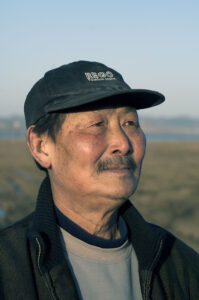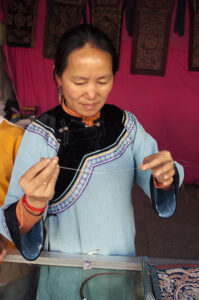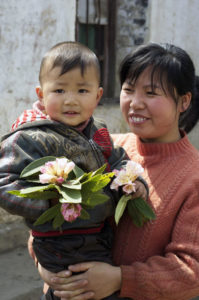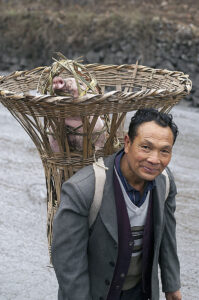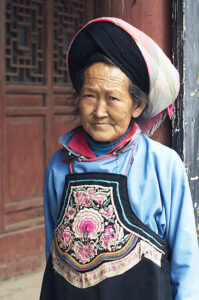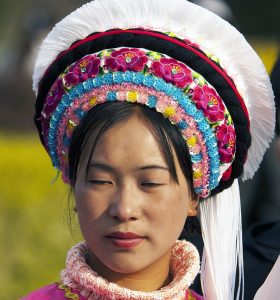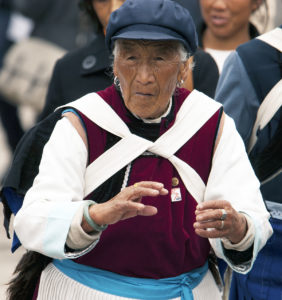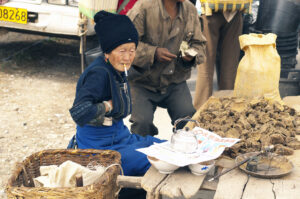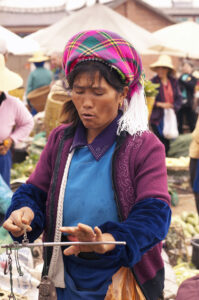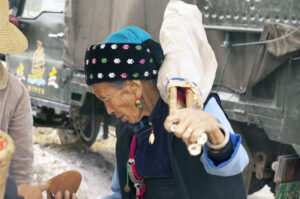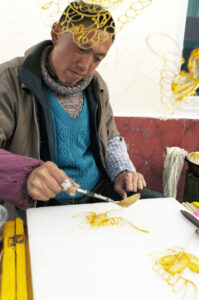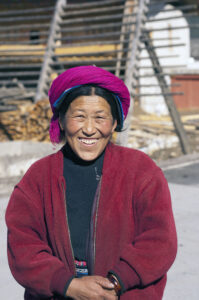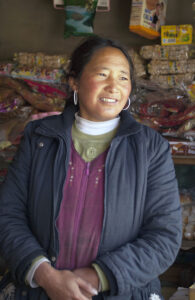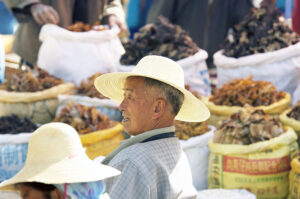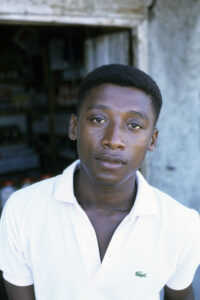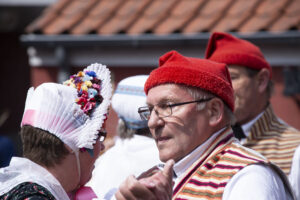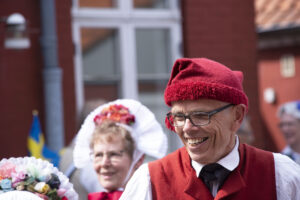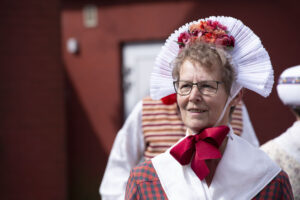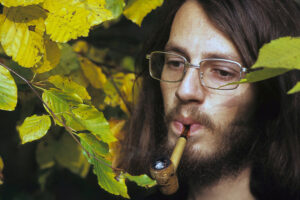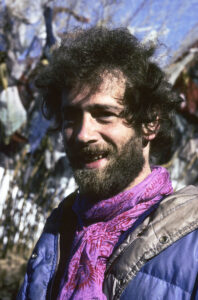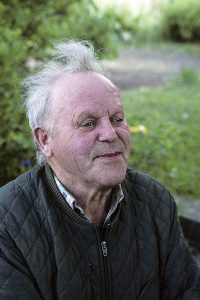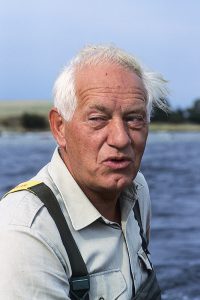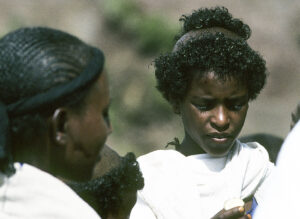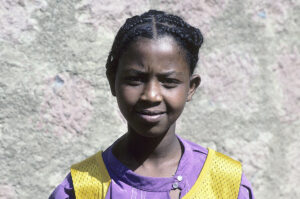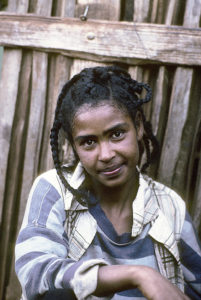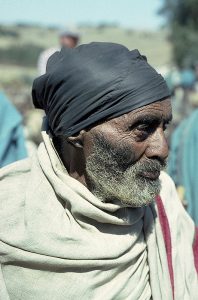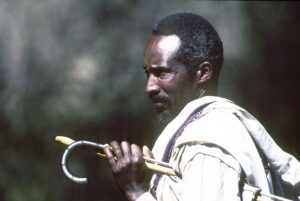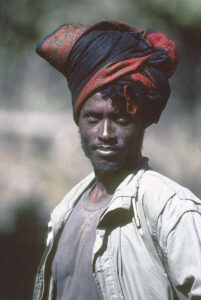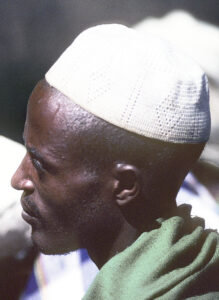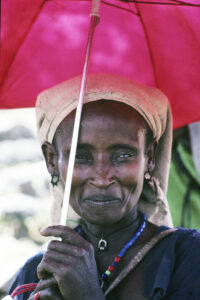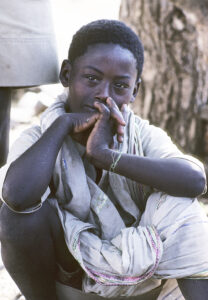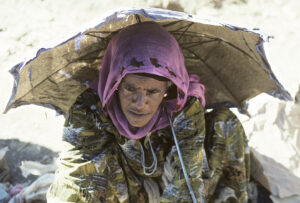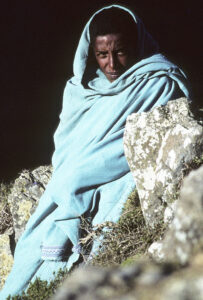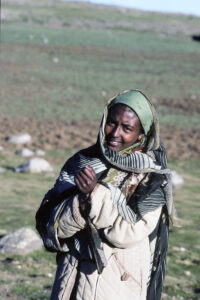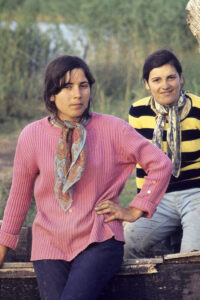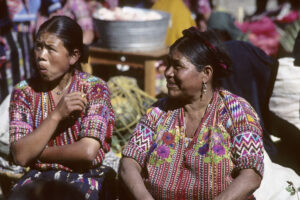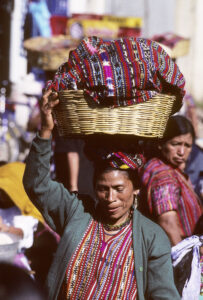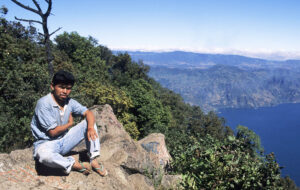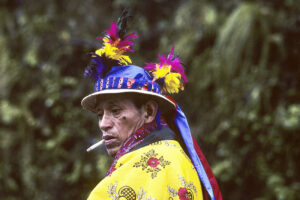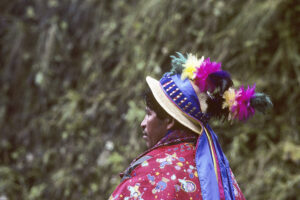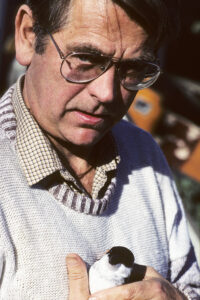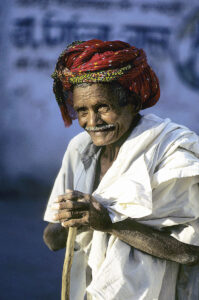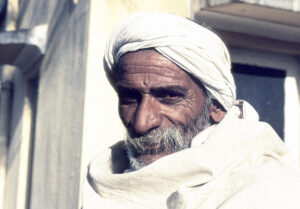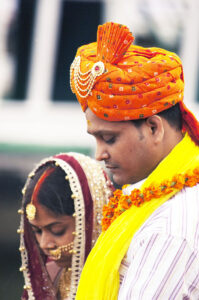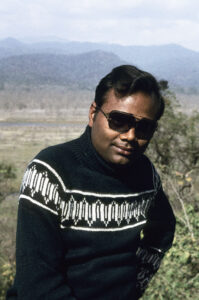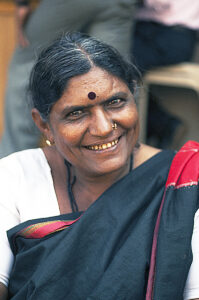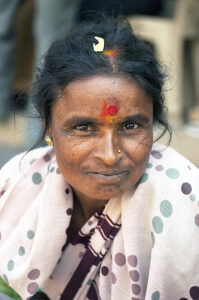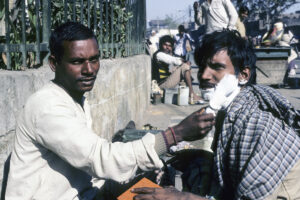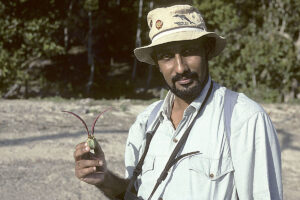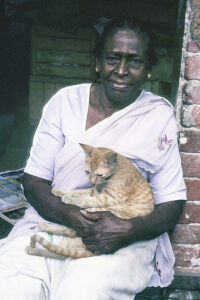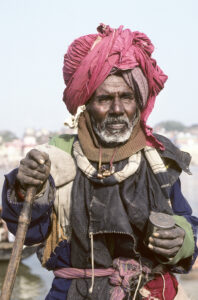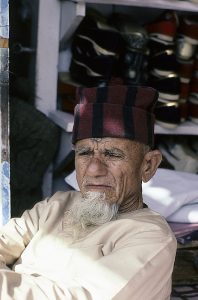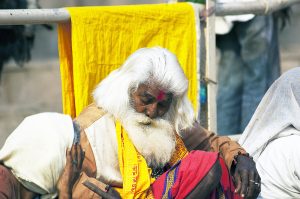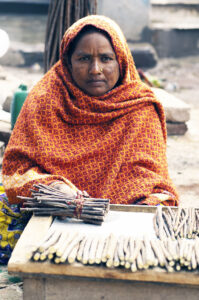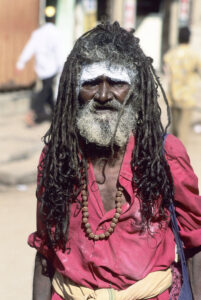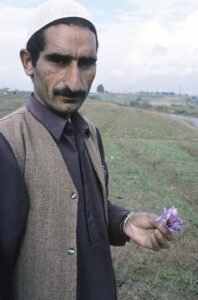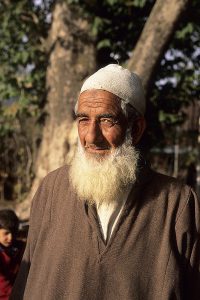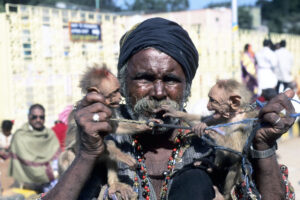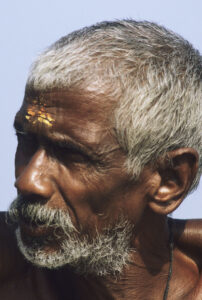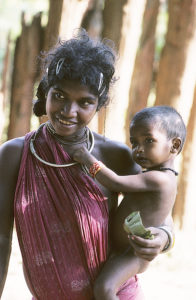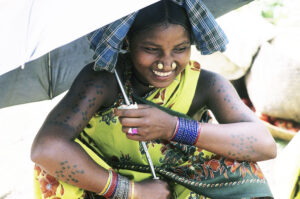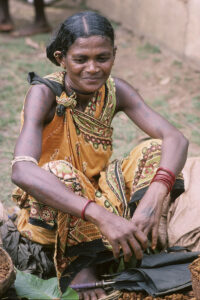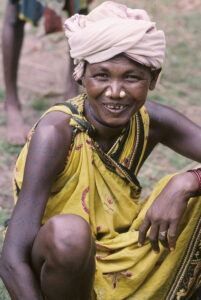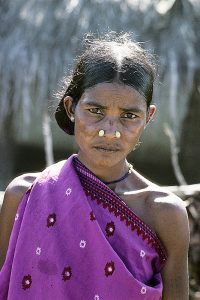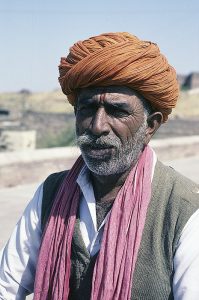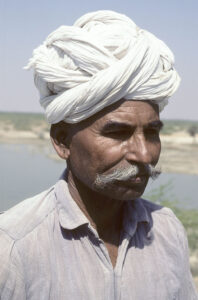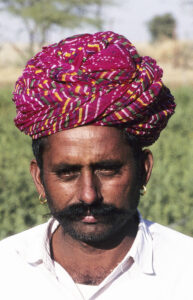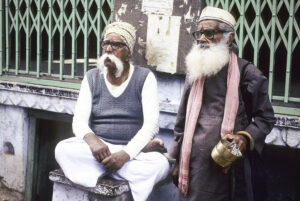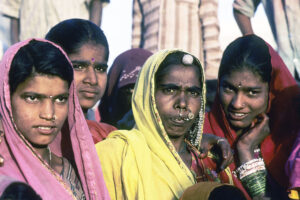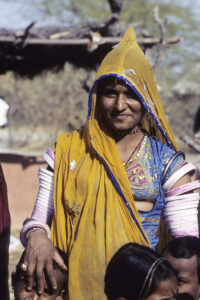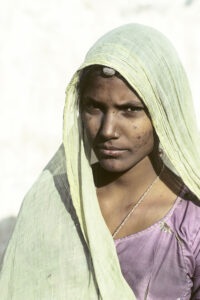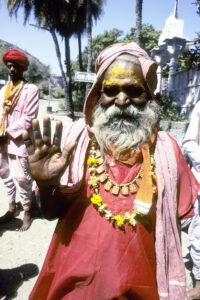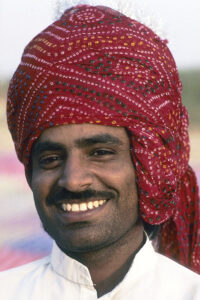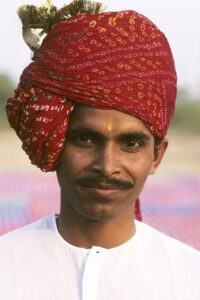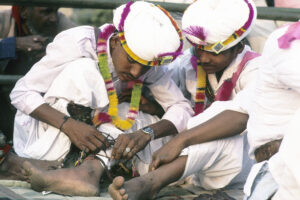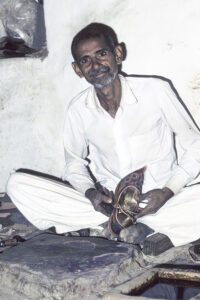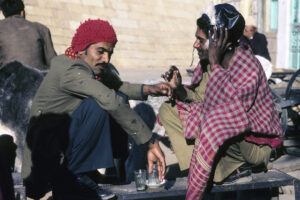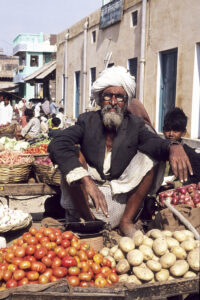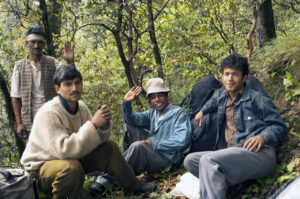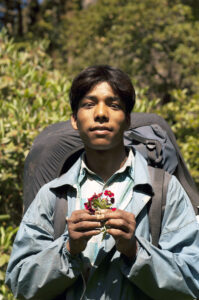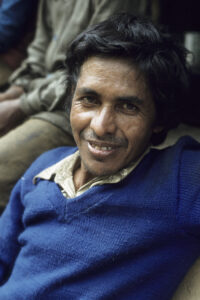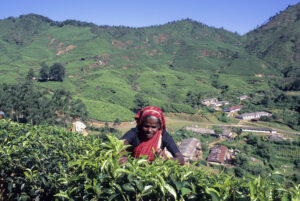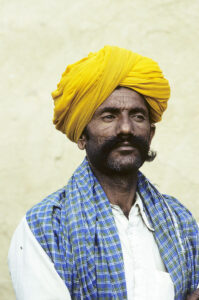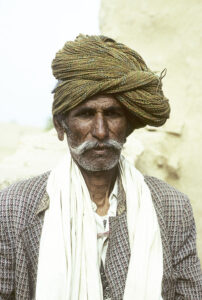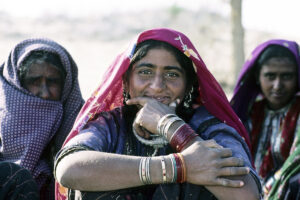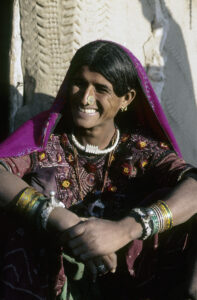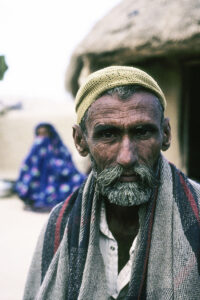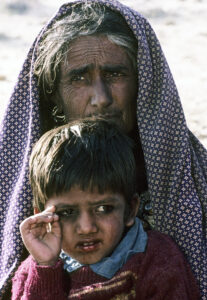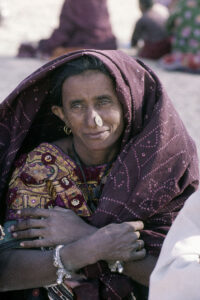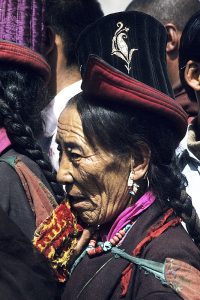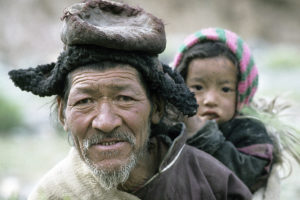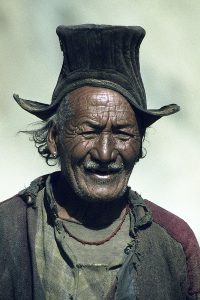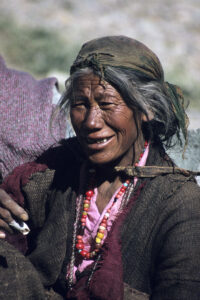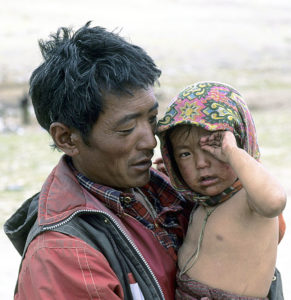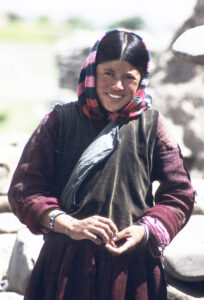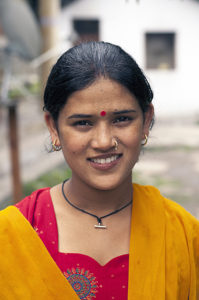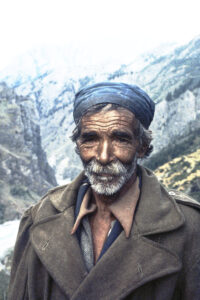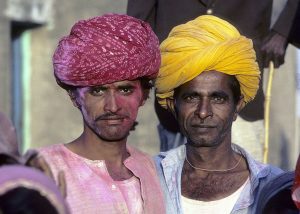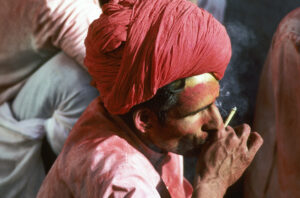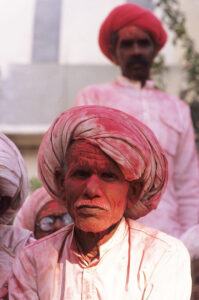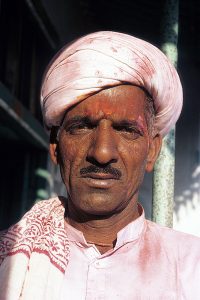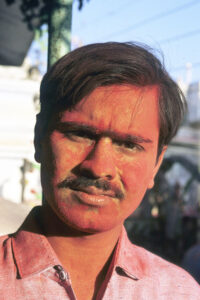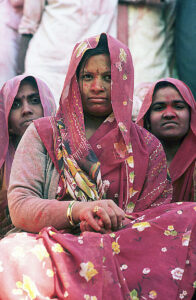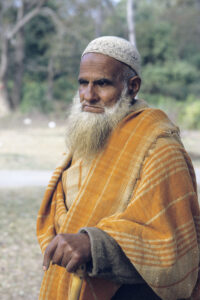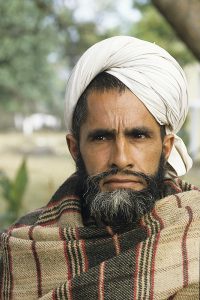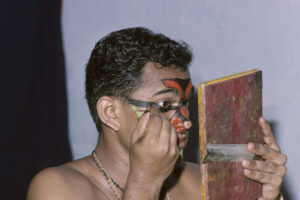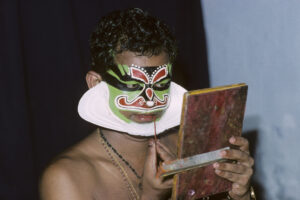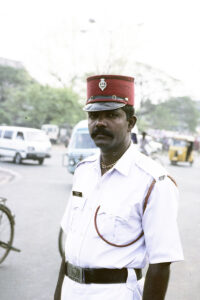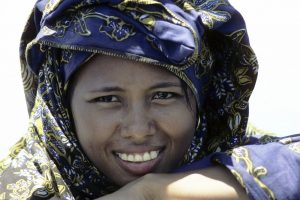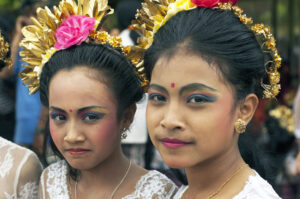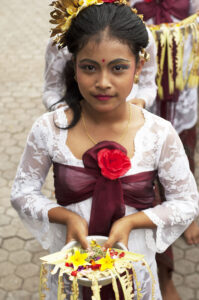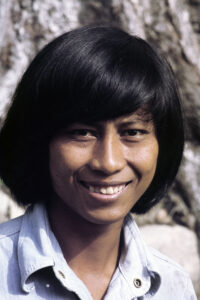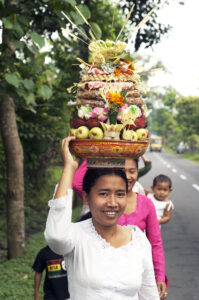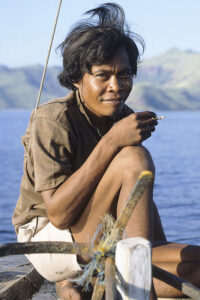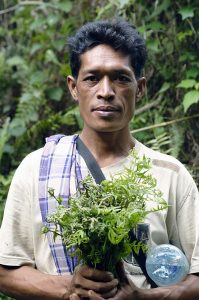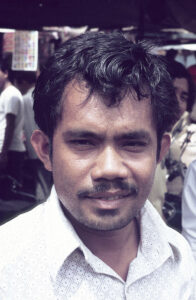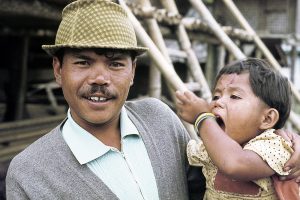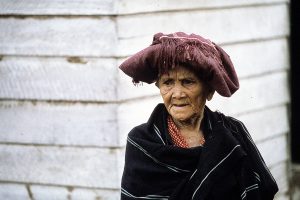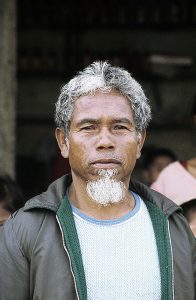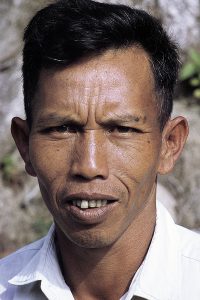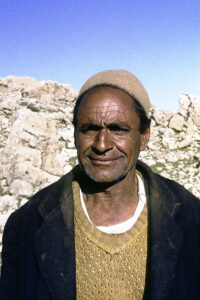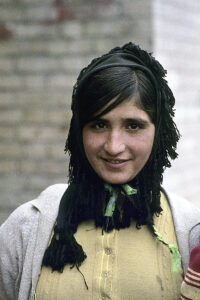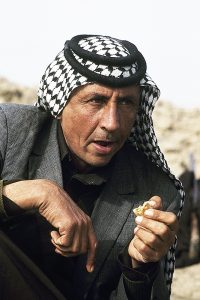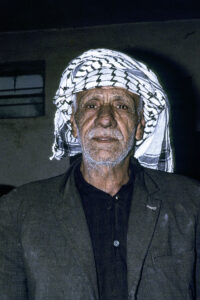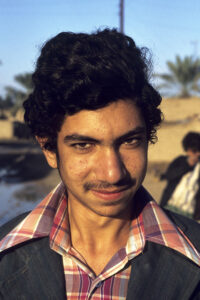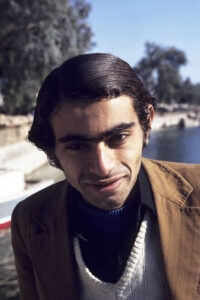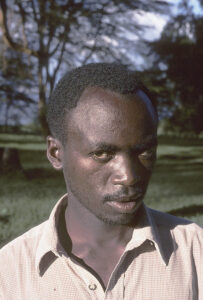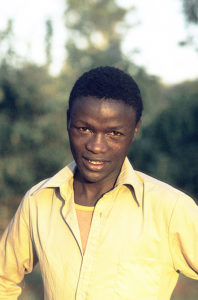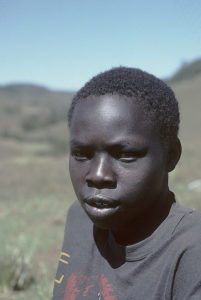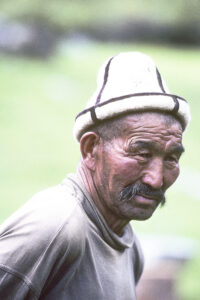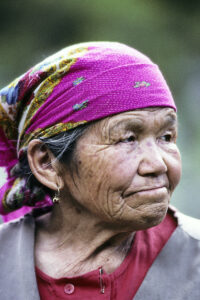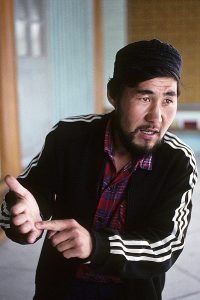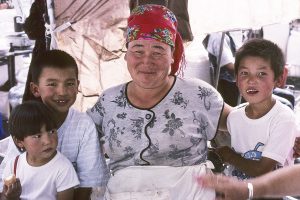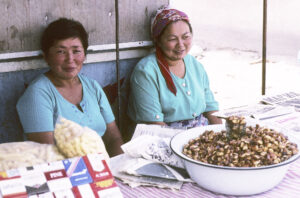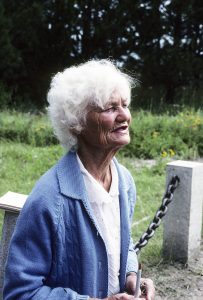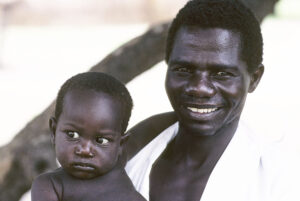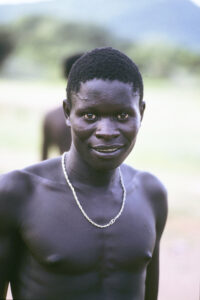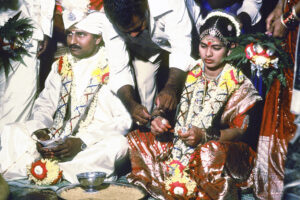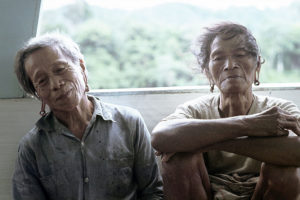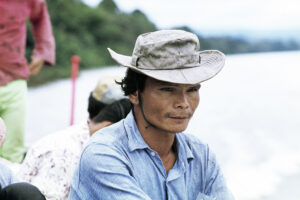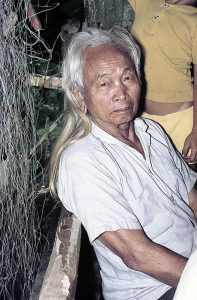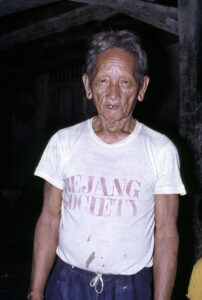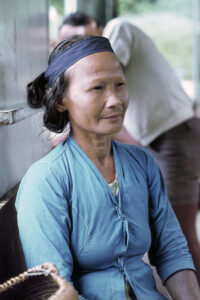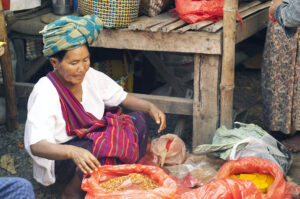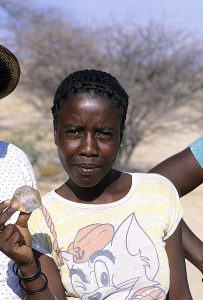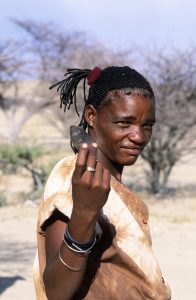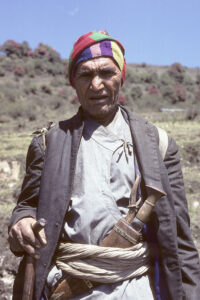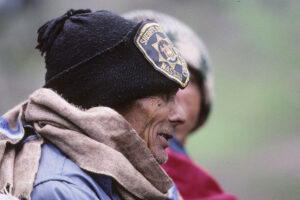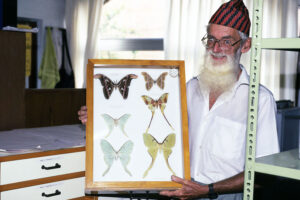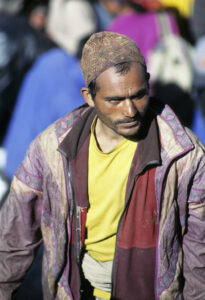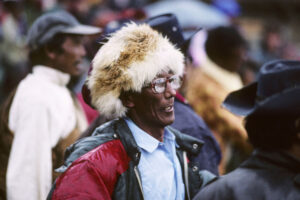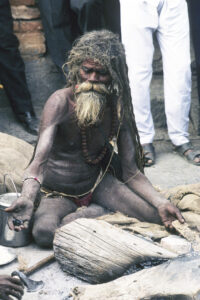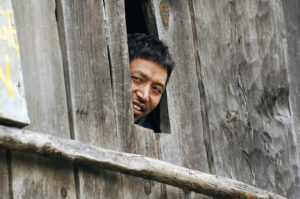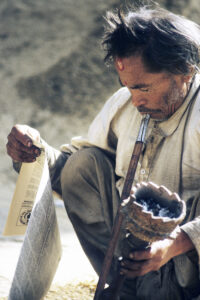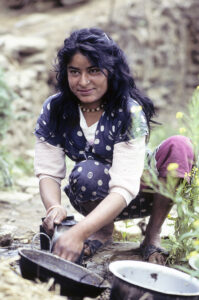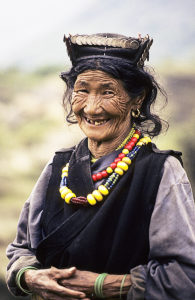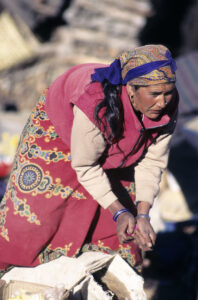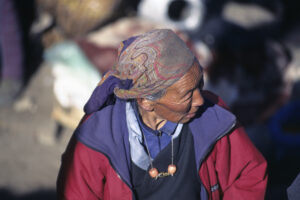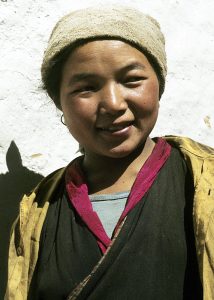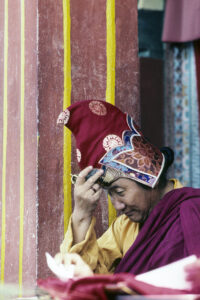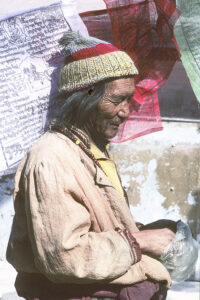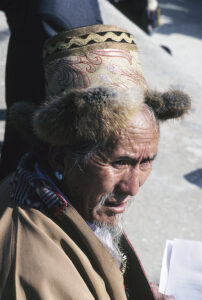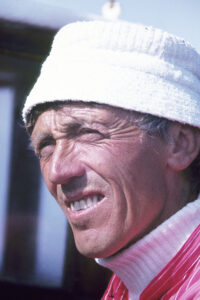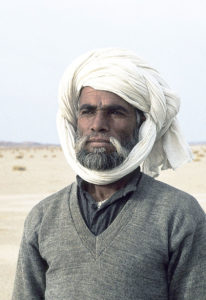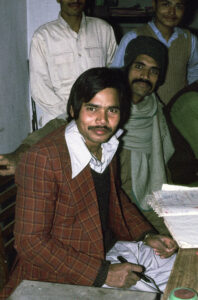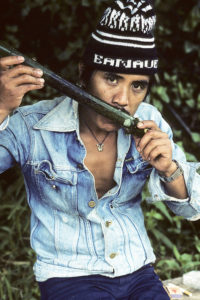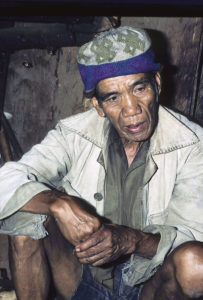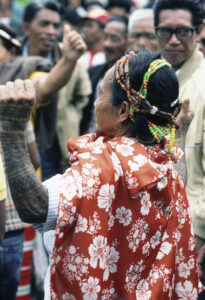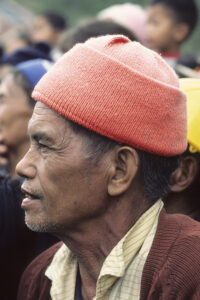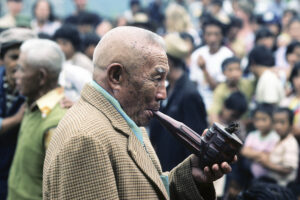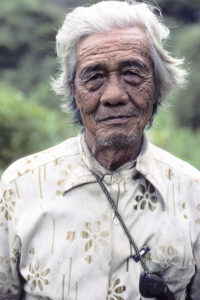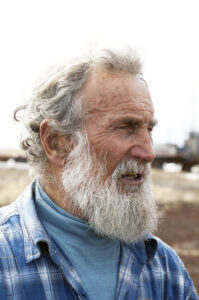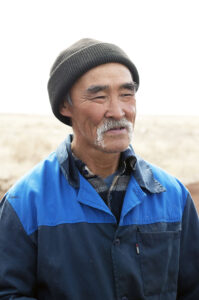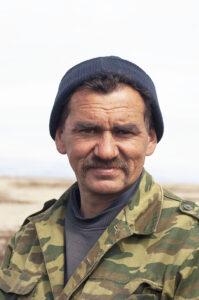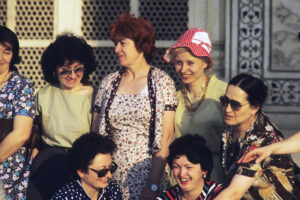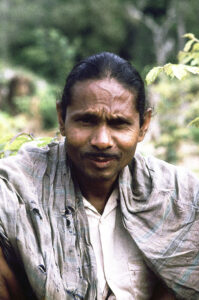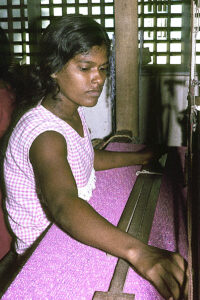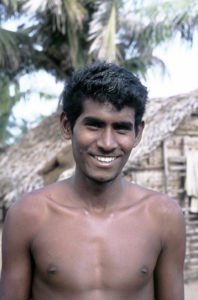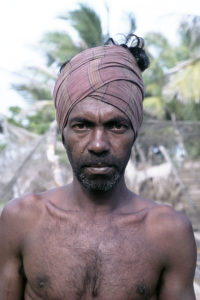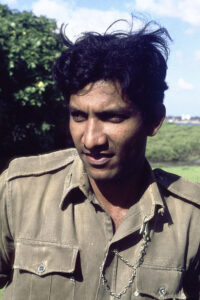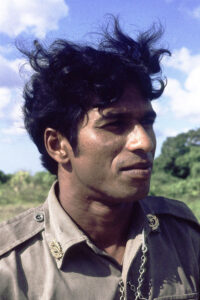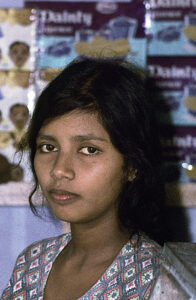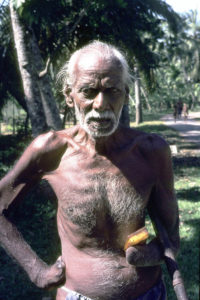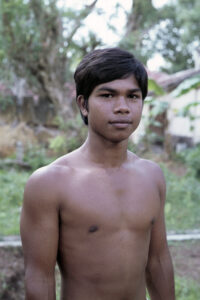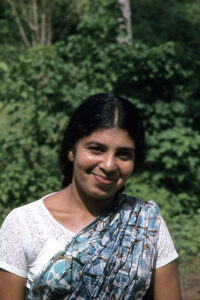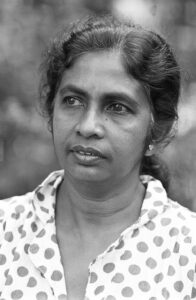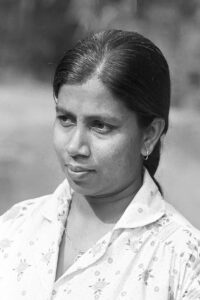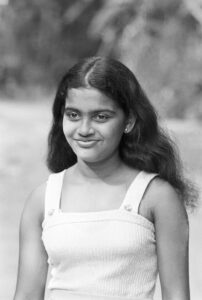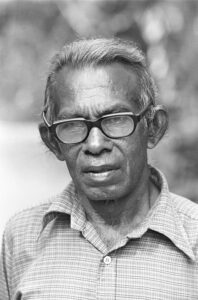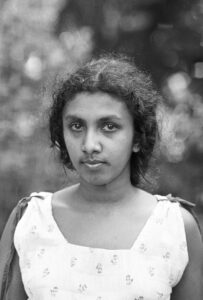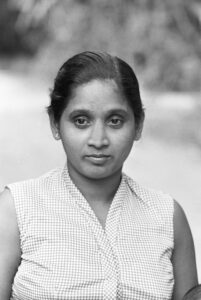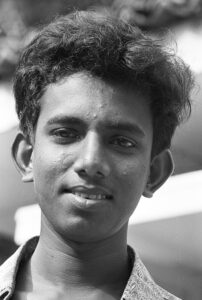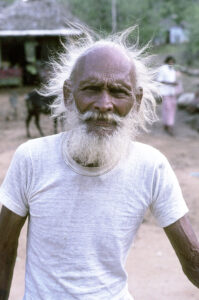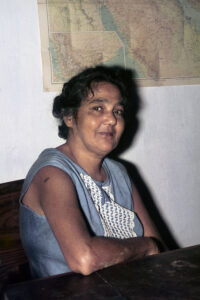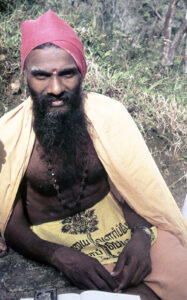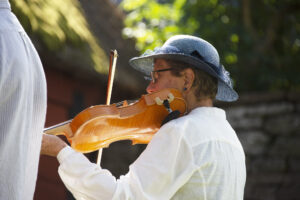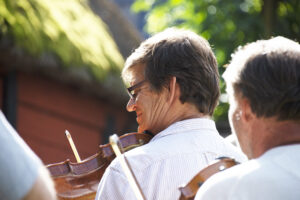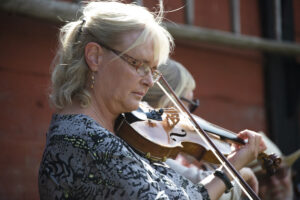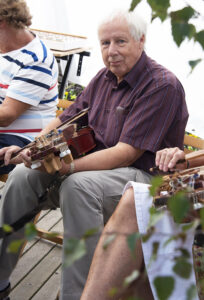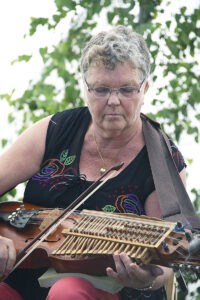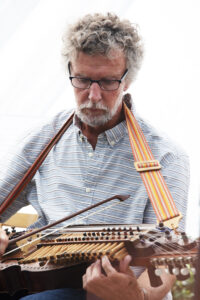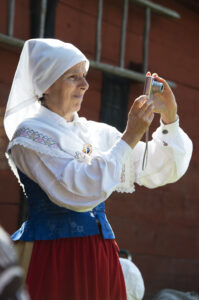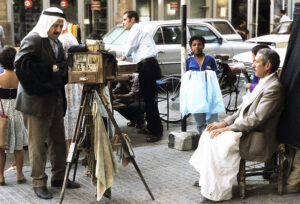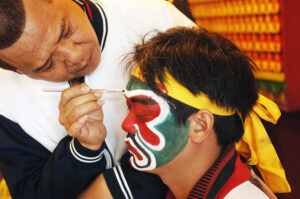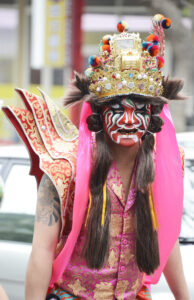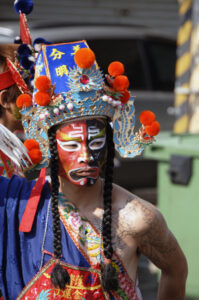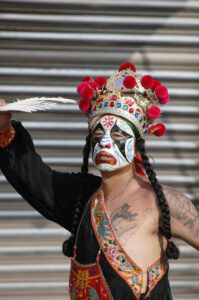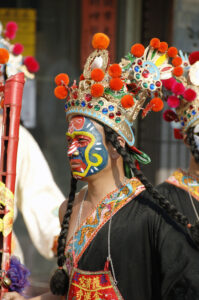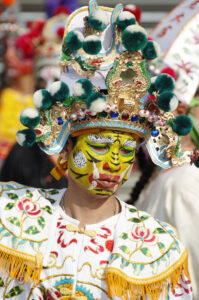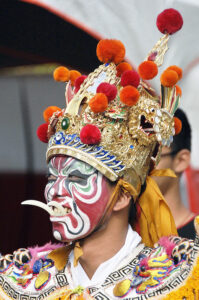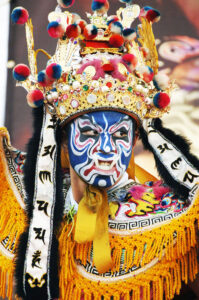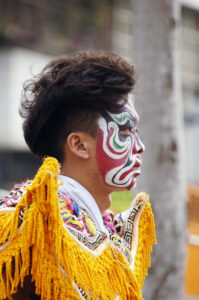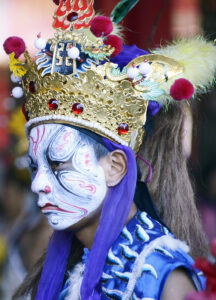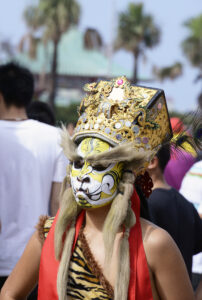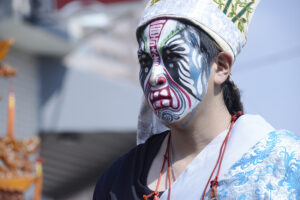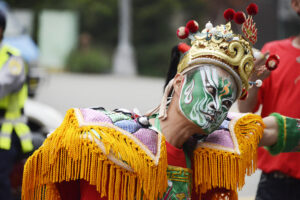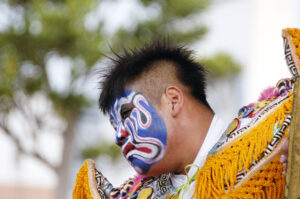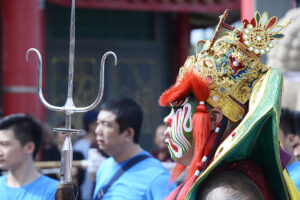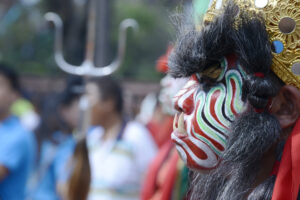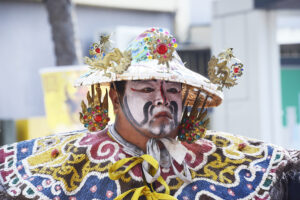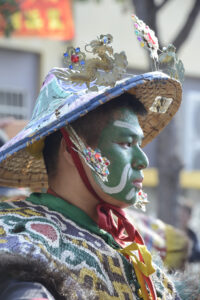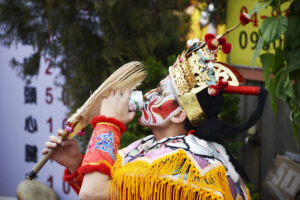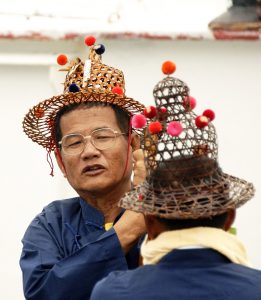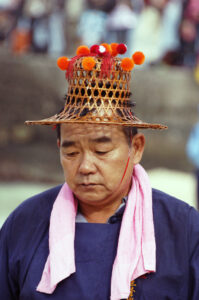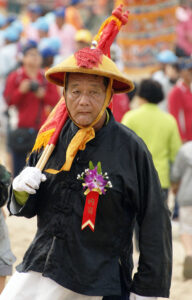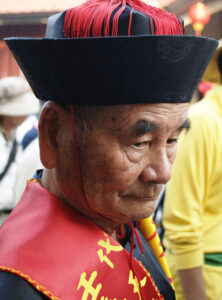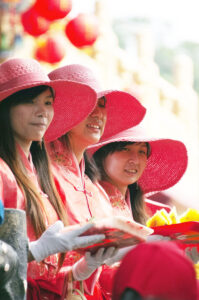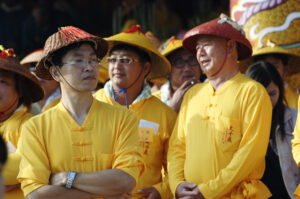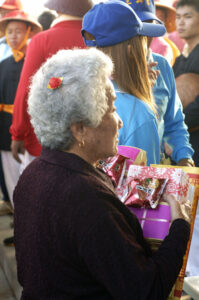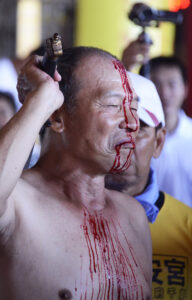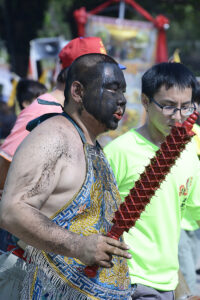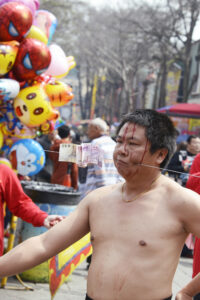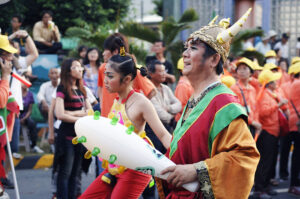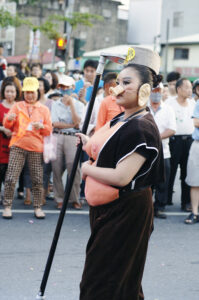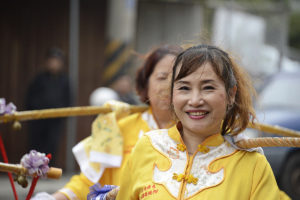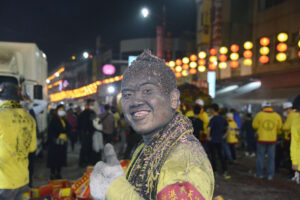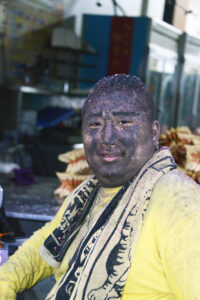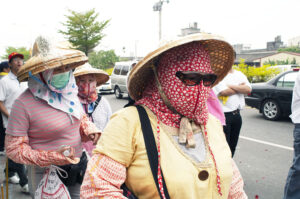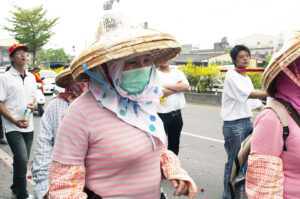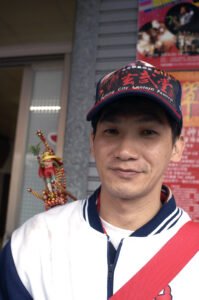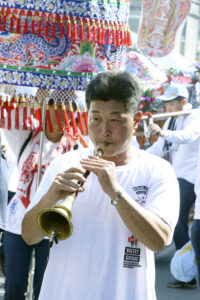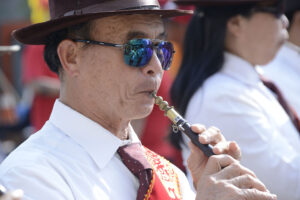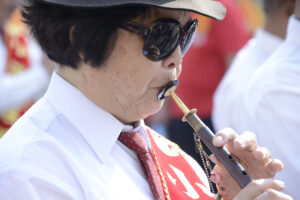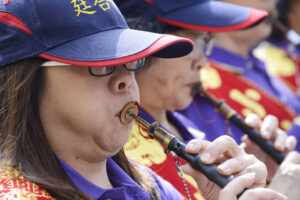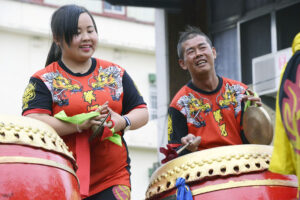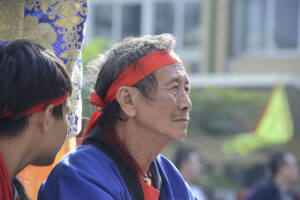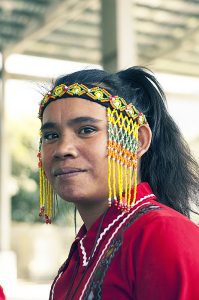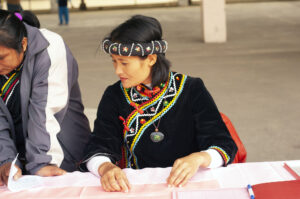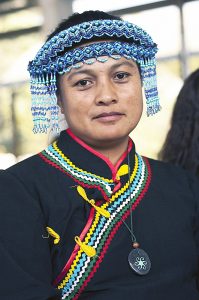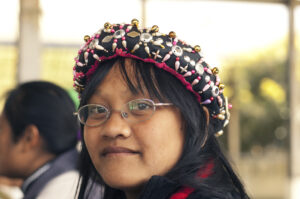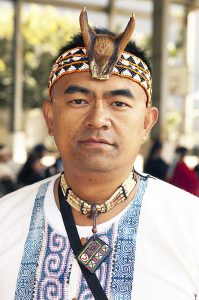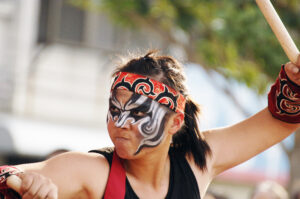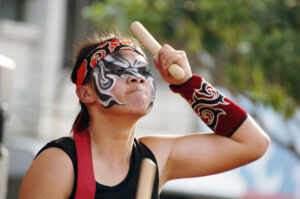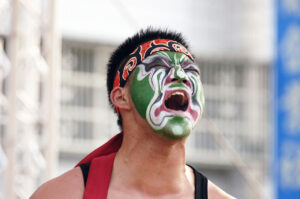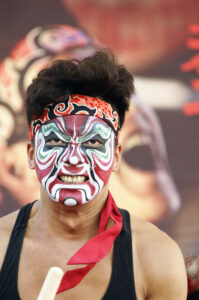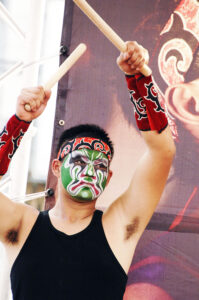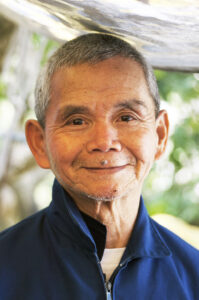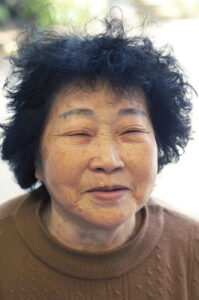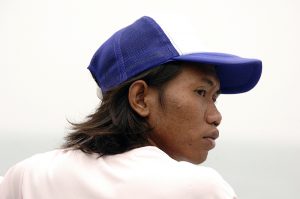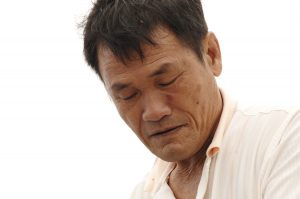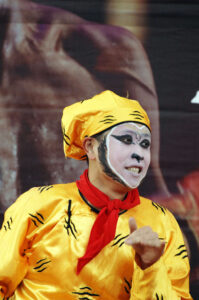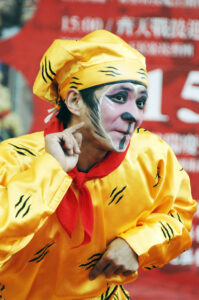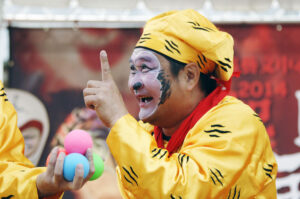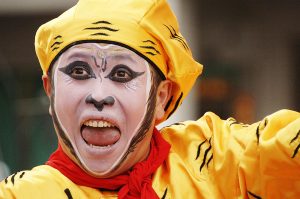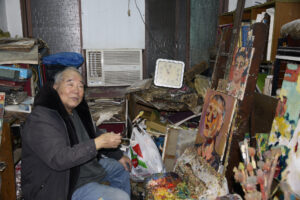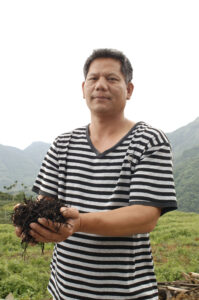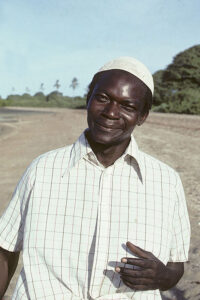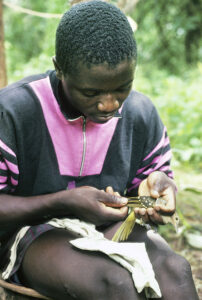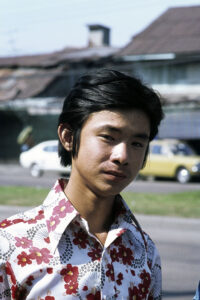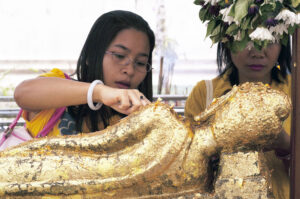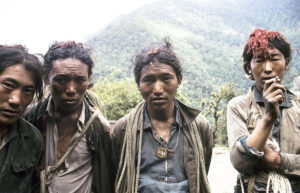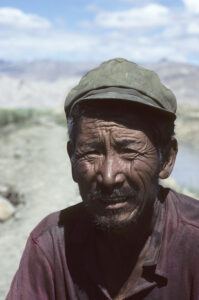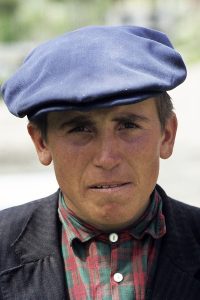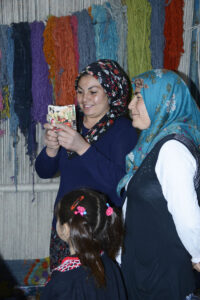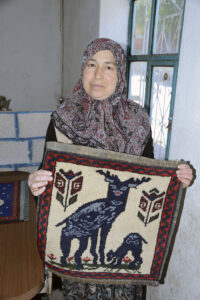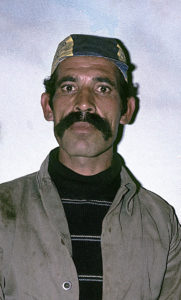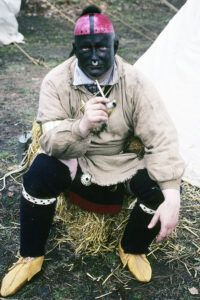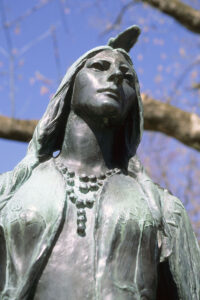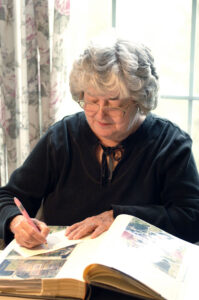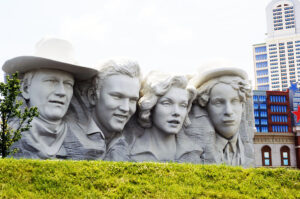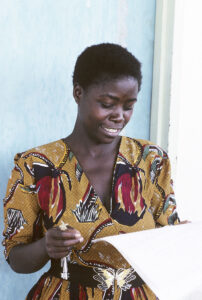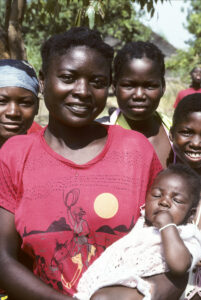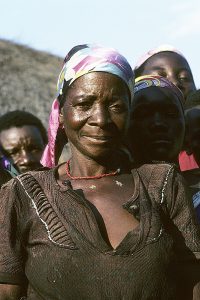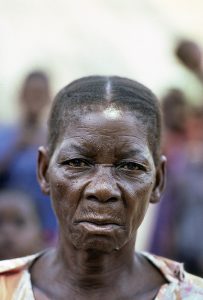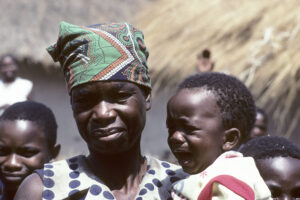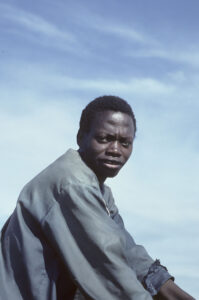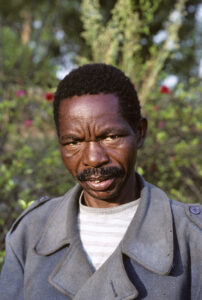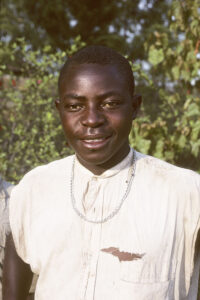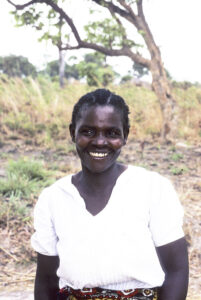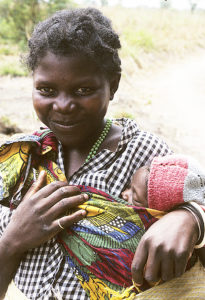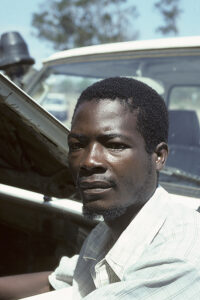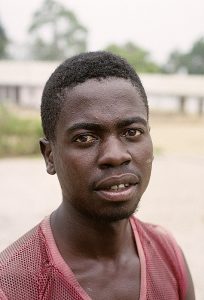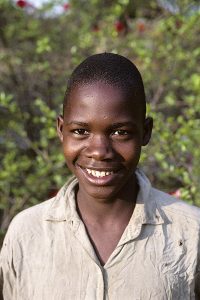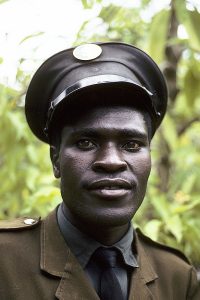Portraits
My sundried vegetables are the best! – In the enchanting old village of Chingliao, near Chiayi, south-western Taiwan, Judy and I met this elderly woman, who was selling dried vegetables. When Judy remarked that they were a bit expensive, she pointed out that they had been dried in the sun, and that they were so good that we would surely come back for more! As it later turned out, they were really tasty, but, unfortunately, Chingliao is far from where we live. (Photo copyright © by Kaj Halberg)
This young beauty, encountered in Nechisar National Park, Ethiopia, has a peculiar hairstyle. (Photo copyright © by Kaj Halberg)
Young Sinhalese, south-western Sri Lanka. (Photo copyright © by Kaj Halberg)
Henrik Olsen, a Danish Caucasian of the blond Nordic type. (Photo copyright © by Kaj Halberg)
Hindu Brahmin, Varanasi, India. Brahmins and other aspects of Hinduism are described on the page Religion: Hinduism. (Photo copyright © by Kaj Halberg)
Pictures, depicting infants and smaller children, are shown on the page People: Children around the world.
Afghanistan
Young man, Kandahar. (Photo copyright © by Kaj Halberg)
The Hazara partly descend from immigrating Mongolians or Central Asian Turks, who settled in Afghanistan around the 1200s. Their facial features, as well as part of their culture and language, differ from those of other Afghani tribes. Most Hazara are Shi’a Muslims, as opposed to other tribes of the country, who are mainly Sunni.
The origin of these factions of Islam is described on the page Travel episodes – Asia & Europe 1975: Long journey home.
Hazara boy, Kandahar. (Photo copyright © by Kaj Halberg)
Algeria
This man enjoys a cigaret, Arak. (Photo copyright © by Kaj Halberg)
Austria
These girls are working in a bar in a hotel in Lammartal Valley. (Photo copyright © by Kaj Halberg)
In the village of Prägraten, Virgen Valley, Tirol, my companion Lars Skipper and I attended a music festival, in which people from the surrounding villages, clad in traditional dresses, participated.
(Photos copyright © by Kaj Halberg)
Cameroun
Happy man, Kapsiki Mountains. (Photo copyright © by Kaj Halberg)
Woman in a village near Garoua. (Photo copyright © by Kaj Halberg)
China
The vast majority of people in China are Han Chinese, constituting more than 90% of the population, besides huge numbers, who have emigrated to other countries. Officially, the Chinese government recognizes 55 ethnic minority groups within Chinese territories, comprising c. 8.5% of the population.
A number of pictures, depicting Chinese tribal peoples, may be studied on the page People: Chinese minorities.
Pictures from Tibet are shown separately under ‘Tibet’.
Chinese biologist Li Ching, showing a gorgeous flower of Magnolia liliflora, which we observed on the Suei Gau Fong Mountain, Guizhou Province. Our adventures with Li Ching are related on the page Travel episodes – China 2009: Among black-necked cranes. (Photo copyright © by Kaj Halberg)
Li Ching’s father, Li Ruor-xien, Weining, Guizhou Province. Together, they were surveying a flock of the threatened black-necked crane (Grus nigricollis), which spends the winter in this area. (Photo copyright © by Kaj Halberg)
Clad in traditional dress, this Shuei tribal woman produces thread from horsetail hairs, Guizhou Province. (Photo copyright © by Kaj Halberg)
Mother and son with rhododendron flowers, Wumeng Shan Mountains, Guizhou Province. (Photo copyright © by Kaj Halberg)
This man in Suicheng (‘Water Village’), Guizhou Province, is on his way home, carrying a pig, which he has bought at a market, in a basket. (Photo copyright © by Kaj Halberg)
An elderly woman outside a Daoist temple on Fung Shan (‘Phoenix Mountain’), Guizhou Province. (Photo copyright © by Kaj Halberg)
The Yunnan Province of south-western China is home to at least 25 tribal peoples, who often wear very colourful traditional dresses. This young woman of the Bai minority is posing for tourists in the city of Dali. (Photo copyright © by Kaj Halberg)
An elderly woman of the Nakhi people (also called Naxi), clad in traditional dress, performs a dance in the town of Lijiang. (Photo copyright © by Kaj Halberg)
Market in a town near Lake Er Hai, Yunnan. (Photos copyright © by Kaj Halberg)
This street vendor in the city of Zhongdian, Yunnan, produces figures from melted sugar. (Photo copyright © by Kaj Halberg)
Tibetan women, east of Zhongdian. (Photos copyright © by Kaj Halberg)
This man is selling goods at a market, Xizhou, Yunnan. (Photo copyright © by Kaj Halberg)
Comoro Islands
Young man, Iconi, Grande Comore. (Photo copyright © by Kaj Halberg)
Denmark
Danes, Swedes, and Norwegians are historically linked to the Norse Vikings, seafarers of Germanic origin, whose conquests and commercial travels during the Viking Age (c. 793–1066) are legendary. Since then, immigration and numerous invasions have had the effect that the Nordic peoples today are of mixed descent, as is evident from the collection of pictures below.
A small percentage of Nordic peoples have red hair or beard. (Photo copyright © by Kaj Halberg)
Folk dancers, wearing local dresses, Bornholm. (Photos copyright © by Kaj Halberg)
Young man, enjoying a pipe of tobacco among autumn leaves of beech (Fagus sylvatica), Jutland. (Photo copyright © by Kaj Halberg)
Young man, trekking in Nepal. (Photo copyright © by Kaj Halberg)
Two elderly men, Jutland. (Photos copyright © by Kaj Halberg)
In January-March 1988, I and other Danish birdwatchers participated in an expedition to Tanzania, the purpose of which was to estimate the number of wintering Palaearctic birds along the Tanzanian coast. Transportation along the coast took place on board a rented sailboat, the Gaia Quest, a 12-metre-long ketch, owned by Englishman Richard Speir. Besides Captain Speir, the boat was manned by First Mate Neil Murray, likewise English, and an Irish cook, Siobhan Bigger (see below at Ireland).
Our adventures during this expedition are related on the page Travel episodes – Tanzania 1988: Experiencing African bureaucracy.
Richard Speir at the helm on board Gaia Quest, off the coast of Tanzania. (Photo copyright © by Kaj Halberg)
Ethiopia
Ethiopia is home to a multitude of peoples, mainly of Hamitic origin, the largest of which are the Amhara, counting about 20 million, or c. 27% of the country’s population. The pictures below show people from various regions of this vast country. Other pictures may be seen in the gallery at People: Tribals of Ethiopia.
In 1996, I attended an orthodox Christian festival in Lalibela, described on the page Travel episodes – Ethiopia 1996: Timkat – a Christian festival. In this picture, a young female pilgrim with a peculiar hairstyle attends the festival. (Photo copyright © by Kaj Halberg)
Girl, Lalibela. (Photo copyright © by Kaj Halberg)
Young beauty with braids, Negelle. (Photo copyright © by Kaj Halberg)
Elderly Amharic at a market in the town of Kayet. (Photo copyright © by Kaj Halberg)
Villagers near the Genale River. The white cap is typical of this area. (Photos copyright © by Kaj Halberg)
Woman and boy, Nechisar National Park. The woman is blind on one eye from trachoma. (Photos copyright © by Kaj Halberg)
Female vendor in a market, protecting herself from the fierce sunshine under an umbrella, Bahir Dar, Lake Tana. (Photo copyright © by Kaj Halberg)
Young man and young woman in the cool highland at Gosh Meda, Simien Mountains. (Photos copyright © by Kaj Halberg)
Greece
Girls, working in a tobacco field, Koroneia. (Photo copyright © by Kaj Halberg)
Guatemala
Our adventures in this country are related on the page Travel episodes – Guatemala 1998: Country of the Mayans.
These women, attending a market in the town of Solola, are wearing a local dress, called a huipil, woven and sown by the women themselves. (Photos copyright © by Kaj Halberg)
When I wanted to climb the volcano San Pedro, at Lago Atitlan, several people warned me against robbers. To feel more secure, I asked a local boy, who was working in a field, if he would join me to the top of the mountain. He agreed, and we spent some pleasant hours together.
My guide, resting near the top of the San Pedro volcano. (Photo copyright © by Kaj Halberg)
The ‘Day of the Dead’, November 1, is the day when Catholics honour deceased family members. In the town of Todos Santos (’All Saints’), a spectacular horse race takes place every year at this time.
During the Festival of the Dead, these men are dressed up for participating in the horse race in Todos Santos. (Photos copyright © by Kaj Halberg)
Iceland
In the autumns of 1989 and 1991, I participated in the joint Danish-Icelandic Greenland Sea Project on board the Icelandic research ship Bjarni Sæmundsson, counting birds and whales along transects in the northern Atlantic Sea, in the area between Greenland, Jan Mayen, and Iceland.
Several pictures from these trips are shown on the page Animals – Birds: Gulls, terns and skimmers.
Leader of the Greenland Sea Project, Svend Aage Malmberg, holding a little auk (Alle alle), which was stuck in a fishing net, but still alive. When it had recovered, it was released. (Photo copyright © by Kaj Halberg)
Þór Jakobsson, meteorologist on board the research ship Bjarni Sæmundsson, measuring the wind force in the Denmark Strait. (Photo copyright © by Kaj Halberg)
India
The vast Indian Subcontinent is home to a multitude of peoples of Aryan, Dravidian, or Austronesian origin.
This elderly man in Udaipur, Rajasthan, greeted me with a friendly smile. (Photo copyright © by Kaj Halberg)
Villager, near Sawai Madhopur, Rajasthan. (Photo copyright © by Kaj Halberg)
Hindu wedding ceremony at the Ganges River, Varanasi. (Photo copyright © by Kaj Halberg)
Forester, Corbett National Park, Uttarakhand. (Photo copyright © by Kaj Halberg)
Dravidian Hindu women in the town of Karwar, Karnataka, South India. The mark on their forehead, called tika, indicates their status as married women. Multi-coloured tika marks, as the one on the forehead of the woman in the lower picture, are usually applied only during Hindu festivals. (Photos copyright © by Kaj Halberg)
Street shaving, Delhi. (Photo copyright © by Kaj Halberg)
Indian forester Ajai Saxena with a fruit of Dipterocarpus incanus, Chidiyatappu, Andaman Islands. Trees of this genus, of which some may reach a height of 40 m, dominate the interior forests on these islands. The Latin name means ‘two-winged seed’. (Photo copyright © by Kaj Halberg)
“Would you like a cat?” this Malayalam woman asked me at the Kannimera Market, Thiruvananthapuram, Kerala. (Photo copyright © by Kaj Halberg)
This beggar in Varanasi is wearing a huge turban and is clad in several layers of clothes, as a protection against the winter cold on the northern plains. (Photo copyright © by Kaj Halberg)
Muslim shoemaker, Jaipur, Rajasthan. (Photo copyright © by Kaj Halberg)
Hindu beggar with immaculately combed hair and beard, Varanasi. (Photo copyright © by Kaj Halberg)
This woman sells ‘toothbrushes’, made from twigs of the neem tree (Azadirachta indica), which has bacteria-killing properties, Varanasi. (Photo copyright © by Kaj Halberg)
I met this Dravidian holy Hindu man, a saddhu, in the great Minakshi Temple in Madurai, Tamil Nadu, India. Saddhus are described in depth on the page Religion: Hinduism. (Photo copyright © by Kaj Halberg)
Kashmiri man with flowers of saffron crocus (Crocus sativus), Pampur, Kashmir. This praised spice, which is widely cultivated in Kashmir, is described on the page In praise of the colours violet, purple and lilac. (Photo copyright © by Kaj Halberg)
Elderly Muslim, Pahalgam, Kashmir. (Photo copyright © by Kaj Halberg)
This street entertainer in the city of Tirumalai, Andhra Pradesh, has caught two young bonnet macaques (Macaca radiata), which he is going to train to perform. They seem to be arguing about something. (Photo copyright © by Kaj Halberg)
This man makes an income by rowing tourists up and down the Ganges River, Varanasi, Uttar Pradesh. (Photo copyright © by Kaj Halberg)
Aboriginals of India are small people, many of Australoid descent, which lived in the forests for thousands of years. When the Dravidians, and later the Aryans, invaded India, these tribal peoples were driven into remote areas. Many still live in the states of Odisha (formerly named Orissa), Chattisgarh, and Madhya Pradesh.
Unfortunately, the culture and way of living of these peoples are rapidly disintegrating, and many have lost their land to entrepreneurs, who extract coal, iron and other minerals from it. Owners of paper factories have persuaded several of the tribes to plant eucalyptus trees on their land, promising these people a large outcome from these trees. However, they omit to inform them that eucalyptus trees dry out the soil, often leading to scarcity of water in areas, which were previously covered in lush forest.
The pictures below were taken in Odisha in 1997, when many tribal peoples had preserved part of their traditional ways.
Young Sabara mother with her infant son, Sabari River. (Photo copyright © by Kaj Halberg)
Paraja tribal vendors at a market in the town of Kotpad. Note the tattoos on the arms of three of the women. (Photos copyright © by Kaj Halberg)
Koya boy. (Photo copyright © by Kaj Halberg)
Between 600 and 1500 A.D., the state of Rajasthan, north-western India (in those days called Rajputana), was divided among numerous rivalling Hindu kingdoms, ruled by Rajputs (‘Sons of Rajas’).
They managed to persuade Brahmins (Hindu priests) to produce genealogical tables, which connected them with the sun, the moon, and the Hindu god of fire, Agni.
These people were born warriors, divided into 36 royal clans. Because of their internal rivalries, each Rajput king ordered his people to build forts and other strongholds to protect himself and his nobles against enemies. Naturally, nobody worried about the safety of the common people.
Rajputs are described in depth on the page Travel episodes – India 1986: “His name is Muhammed!”
Like most men in Rajasthan, these men wear a turban. (Photos copyright © by Kaj Halberg)
Elderly men with bushy beards, Jodhpur. (Photo copyright © by Kaj Halberg)
Hindu women in the village of Seventri. (Photo copyright © by Kaj Halberg)
Young women of the weaver’s cast, near Jodhpur. (Photos copyright © by Kaj Halberg)
A friendly Hindu brahman (roughly corresponding to a priest) in front of a Hanuman temple, Charbhuja. (Photo copyright © by Kaj Halberg)
Turban-clad dancers, participating in a camel festival in the city of Bikaner, Thar Desert. (Photos copyright © by Kaj Halberg)
This dancer at the camel festival is tying bells to a fellow dancer’s leg, Bikaner. (Photo copyright © by Kaj Halberg)
Shoemaker, producing leather slippers, Jaisalmer. (Photo copyright © by Kaj Halberg)
Men talking and drinking tea, Jaisalmer. (Photo copyright © by Kaj Halberg)
Street vendor, selling potatoes, tomatoes, and onions, Bharatpur, Rajasthan. (Photo copyright © by Kaj Halberg)
Pratap Singh, Dilip, Jai Singh, and Roop Chand, members of my trekking staff, Great Himalayan National Park, Himachal Pradesh. (Photo copyright © by Kaj Halberg)
In this picture, Jai Singh has picked a few cinquefoils of the species Potentilla argyrophylla. (Photo copyright © by Kaj Halberg)
Young man, Govindghat, Uttarakhand. (Photo copyright © by Kaj Halberg)
Tamil woman, picking tea leaves, Munnar, Kerala. (Photo copyright © by Kaj Halberg)
The vast Thar Desert stretches across the western part of Rajasthan and into Pakistan. The main part of this desert is level sand or gravel plains with scattered bushes and trees.
This fascinating area is presented in depth on the pages Travel episodes – India 1986: “Sir, would you like to see this peacock?” and India 2003: Camel safari in the Thar Desert.
Turban-clad men in the Thar Desert. (Photos copyright © by Kaj Halberg)
Muslim people from the village of Bambara in the heart of the Thar Desert, near the Pakistani border. (Photos copyright © by Kaj Halberg)
Formerly, Ladakh was a province in the Indian State Jammu and Kashmir. However, there was a huge resistance in the population against this arrangement, as the Ladakhis, justly, felt that they were treated unfairly by the Muslim government in Srinagar. The people and language of Ladakh are of Tibetan origin, and the dominating religion is Lama Buddhism.
The Indian government has proclaimed that from October 31, 2019, Ladakh constitutes a Union Territory, ruled by the central government in Delhi.
In former days, among the Ladakhi population, the will to share was widespread. There was a common responsibility to keep the water courses clean, as their water was utilized in the households. At harvest time, everybody participated in helping each other. These sympathetic features largely vanished, when the area was opened to tourism in 1972. Today, a common consumer capitalism is prevailing, at least in the cities.
Ladakhi woman, clad in traditional dress, Leh. (Photo copyright © by Kaj Halberg)
Near Umlung, Markha Valley, I encountered this elderly man, carrying his granddaughter on his back. In Ladakh, grandparents are highly respected, and they often participate in the upbringing of their grandchildren. (Photo copyright © by Kaj Halberg)
This shaman from the Markha Valley is wearing the typical high felt hat of the area, and a rosary with 108 beads, made from plant seeds. (108 is a sacred number to Buddhists.) Officially, Ladakhi shamans are Buddhists, but their practice contains many traces from Bon, the pre-Buddhist religion of Central Asia. (Photo copyright © by Kaj Halberg)
This Ladakhi woman from Chyskylmo is wearing two neclaces with corals and other semi-precious stones. (Photo copyright © by Kaj Halberg)
Changpa father and son, encountered on the Pulo Konka La Pass. (Photo copyright © by Kaj Halberg)
This young woman at Stok is clad in a combination of traditional and Western clothes. (Photo copyright © by Kaj Halberg)
Many people in the Indian states of Himachal Pradesh and Uttarakhand are Hindus of Caucasian origin, who migrated here from Rajasthan hundreds of years ago.
This area is described on the pages Travel episodes – India 2008: Mountain goats and frozen flowers, and Plants – Plant hunting in the Himalaya: Abode of the deodar.
Young woman from the town of Gushaini, Tirthan Valley, Himachal Pradesh. The red mark between her eyebrows, called a tika, indicates her status as a married woman. (Photo copyright © by Kaj Halberg)
Elderly man, Lata, Uttarakhand. (Photo John Burke, copyright © by Kaj Halberg)
Holi is a Hindu spring festival, celebrating the god Krishna, and the victory of good over evil – a gay festival, in which people, regardless of caste, pelt each other with red, yellow, purple, or green powder, or with water, dyed with powder. For this reason, Holi has been dubbed The Festival of Colours.
My own ‘colourful’ adventures during this festival are related on the page Travel episodes – India 1991: Attending Hindu festivals in Rajasthan.
In Charbhuja, Rajasthan, where these pictures were taken, Holi lasts no less than 15 days. (Photos copyright © by Kaj Halberg)
The Gujjar-Bakarwals are a tribe of pastoral Muslim nomads, who live in the Indian Himalaya. Although the Rajaji area in Uttarakhand was declared a national park in 1993, these people still live here. Foresters have pointed out that they should be banned from grazing their animals in the park, but, ironically, they seem to benefit wildlife here, as they keep poachers away from the area. For instance, the number of wild Asian elephants (Elephas maximus) in the park has increased in later years. The Gujjars themselves do not harm wildlife, as they are vegetarians.
Gujjar-Bakarwal men, Uttarakhand. (Photos copyright © by Kaj Halberg)
Kathakali is a dancing form, about 500 years old, from Kerala, which may still take place in certain villages. Today, however, it is mostly performed for tourists. This dance relates dramas, in which the theme is most often taken from the Hindu epics Mahabharata and Ramayana (more about these epics on the page Religion: Hinduism). All dancers are males.
This dance is a complicated pantomime, in which not only the dancing movements, but also facial mimic and eye movements are important elements. The dancers are clad in fantastic costumes, and the facial painting, which often takes hours to make, is in vivid colours. The dance is accompanied by drums, and the plot is conveyed through a singer.
Dancers apply make-up before a show in the city of Kochi. (Photos copyright © by Kaj Halberg)
Tamils are a people of South India, numbering around 76 million, thus being the largest Dravidian people. They constitute about 6% of the population in India, 15% in Sri Lanka, 6% in Mauritius, 7% in Malaysia, and 5% in Singapore.
This Tamil policeman in Pondicherry (Puducherri), southern India, is wearing a French style police cap, called a kepi. This union territory was formerly a French colony. (Photo copyright © by Kaj Halberg)
Indonesia
Indonesia is home to a multitude of peoples of Austronesian, Malayan, or Melanesian origin. A collection of pictures below shows a variety of people in this vast archipelago.
The front teeth of this young Muslim woman in the town of Sapé, Sumbawa, have been filed down, probably an ideal of beauty on this island. (Photo copyright © by Kaj Halberg)
Women and girls, dressed in their finery for a dancing performance during a Hindu temple festival, Ubud, Bali. (Photos copyright © by Kaj Halberg)
Young man from Java. (Photo copyright © by Kaj Halberg)
Women, carrying offerings to a Hindu temple, Ubud, Bali. (Photo copyright © by Kaj Halberg)
Young seaman in a local type of sailboat, east of Sumbawa. (Photo copyright © by Kaj Halberg)
During a hike up the volcano Gunung Rinjani, situated on the island of Lombok, our cook Sutardi has collected wild ferns to be used in our evening meal. (Photo copyright © by Kaj Halberg)
Young man, Medan, Sumatra. (Photo copyright © by Kaj Halberg)
The Batak are a group of closely related Austronesian peoples, including the Karo, Pakpak, Simalungun, Toba, Angkola, and Mandailing, who live in a large area of northern Sumatra.
Other pictures, depicting Batak people, may be seen on several other pages on this website, including People: Children around the world, and Culture: Musicians.
Batak people in the area around Lake Toba, Sumatra. (Photos copyright © by Kaj Halberg)
Iran
The Lur are a people who live in the Zagros Mountains in south-western Iran. In 1973, Arne Koch Christoffersen and I spent about six weeks in this area, staying for three weeks in the house of Muhammed, headman of a village name Mirabad. Our, at times, rather bizarre adventures with Muhammed are related on the page Travel episodes – Iran 1973: In the mountains of Luristan.
Lur man, wearing the typical felt cap of the area. (Photo copyright © by Kaj Halberg)
Maria, 16-year-old daughter of Muhammed. (Photo copyright © by Kaj Halberg)
Arab, enjoying his meal, southern Iraq. (Photo copyright © by Kaj Halberg)
Old man, Aziziya, southern Iraq. (Photos copyright © by Kaj Halberg)
Young man from the town of Dawaya, southern Iraq. (Photo copyright © by Kaj Halberg)
Young man, Chibayish, southern Iraq. (Photo copyright © by Kaj Halberg)
Ireland
Siobhan Bigger with a damaged lesser crested tern (Thalasseus bengalensis), which landed on board the ketch Gaia Quest, off the coast of Tanzania. See above at England. (Photo copyright © by Kaj Halberg)
The Kikuyu are a Bantu people, native to Kenya. Numbering about 7 million, they account for about 17% of the total population in the country.
Young Kikuyu men, Lake Naivasha (top) and Nyeri. (Photos copyright © by Kaj Halberg)
The Kalenjin are a group of Southern Nilotic peoples, numbering around 6.3 million, who live in East Africa, mainly in the Rift Valley area in Kenya. One of the tribes is the Pokot, numbering around 900,000 people. They live in western Kenya and eastern Uganda.
Pokot boy, Cherangani Hills. (Photo copyright © by Kaj Halberg)
Kyrgyzstan
The Kyrgyz people (also Kyrghyz or Kirghiz) are a Turkic ethnic group, believed to have descended from the Yenisei Kyrgyz, who originated in central Siberia, around the Yenisei River. Later, this nomadic people spread to large parts of Central Asia, especially to the area, which is today called Kyrgyzstan.
Parts of their land were ceded by the Chinese to the Russian Empire in 1876. Following the Russian revolution in 1919, Soviets took control of the Kyrgyz region, and the Kara-Kyrgyz Autonomous Oblast was created within the Soviet Union. In 1936, a Soviet Republic, named Kirgizskaya Sovetskaya Sotsialisticheskaya Respublika, was established.
As a result of the Russian dominance, a large number of Russians emigrated to the area, and by 1989 they numbered almost one million. Following the breakdown of the Soviet Union, Kyrgyzstan gained independence in 1991, and the majority of Russians in the country returned to Russia.
Today, the Kyrgyz number about 5 million, of which 4.5 million live in Kyrgyzstan. There are about 350,000 Russians in the country.
In the summertime, a small number of Kyrgyz still live a semi-nomadic life. These pictures show an elderly couple, photographed in the Karakol Valley, Tien Shan Mountains. Note the man’s typical felt hat. (Photos copyright © by Kaj Halberg)
Islamic mullah (priest) in the city of Karakol, explaining principles of Islam. (Photo copyright © by Kaj Halberg)
Kyrgyz saleswomen at a market, Karakol. (Photos copyright © by Kaj Halberg)
This elderly Russian woman is working as a tourist guide in Karakol. (Photo copyright © by Kaj Halberg)
Malawi
Lake Malawi is the third-largest lake in Africa, 575 km long and up to 85 km wide, covering an area of c. 23,000 km2. The majority of the population of this area are various Bantu tribes, including the Achewa, who live around the south-western corner of the lake.
My adventures on board a ferry on this lake are related on the page Travel episodes – Malawi 1997: A three-day ferry cruise on Lake Malawi.
Achewa man with his son from the village of Chembe, Lake Malawi. (Photo copyright © by Kaj Halberg)
Achewa man, Chembe. (Photo copyright © by Kaj Halberg)
Malaysia
Hindu wedding, Kuala Lumpur. A man is tying a sacred thread around the wrist of the bride. (Photo copyright © by Kaj Halberg)
The indigenous population of Borneo is a multitude of Malayan tribes, known by the common name Dayaks. My visit to one of these peoples, the Punan, is related on the page Travel episodes – Borneo 1975: Canoe trip with Punan tribals.
Elderly men of the Kayan tribe, Rajang River, Sarawak. (Photo copyright © by Kaj Halberg)
This Dayak man is a passenger in a longboat, which serves as a ferry on the Rajang River. (Photo copyright © by Kaj Halberg)
Punan elders, Sarawak. (Photos copyright © by Kaj Halberg)
Dayak woman, Belaga, Sarawak. (Photo copyright © by Kaj Halberg)
Myanmar
Inthe tribal woman, selling grains and spices at a market, Nyaung Shwe, Lake Inle. (Photo copyright © by Kaj Halberg)
Namibia
The majority of the population of Namibia are various Bantu peoples, of which the largest is the Ovambo, accounting for around half of the population. Other significant groups are Kavango, Herero, Damara, and Caprivi.
The fantastic natural features of Namibia are described on the page Countries and places: Namibia – a desert country.
Bantu women with semi-precious stones, Spitzkoppe. (Photos copyright © by Kaj Halberg)
Nepal
Nepal is home to a multitude of peoples of Mongoloid, Aryan, and mixed origin.
This villager from Gupha Pokhari, eastern Nepal, is wearing a khukuri knife, which is characterized by the curved blade. Formerly, this knife was a traditional weapon of the Gurkhas and Kiratis, but today it serves multiple more peaceful purposes. (Photo copyright © by Kaj Halberg)
Spectator at the Tibetan Yartung Festival, Muktinath, Mustang, Nepal. The badge on his hat says: ‘Sheriff’s Deputy, Nassau County’ – a county on Long Island, New York. Presumably, the hat was a gift from an American tourist. (Photo copyright © by Kaj Halberg)
British entomologist Colin Smith (born 1936) shows spectacular moths, which he collected in Nepal. He has been living in Nepal since 1964, and has made huge collections of butterflies and moths. The picture was taken in Kathmandu in 2002. (Photo copyright © by Kaj Halberg)
Men, paying a visit to the weekly Saturday market in the village of Namche Bazaar, Khumbu, eastern Nepal. (Photos copyright © by Kaj Halberg)
This Shaivit (follower of the god Shiva), smeared in ashes and wearing nothing but a loincloth and a rosary, pays a visit to the Pashupatinath Temple in Kathmandu, one of the most important Shiva temples. (Photo copyright © by Kaj Halberg)
Man in a tiny ‘window’, Sherpagaon, Langtang National Park. (Photo copyright © by Kaj Halberg)
The Kathmandu Valley is mainly inhabited by Newars, a people of mixed Indo-European and Mongolian origin. They number about 1.3 million.
While reading a newspaper, this Newar man enjoys smoking his huge pipe. Hot charcoal in the pipe keeps the tobacco glowing. The tika mark on his forehead is multi-coloured and contains rice grain, indicating that a religious festival is taking place. – Bhaktapur. (Photo copyright © by Kaj Halberg)
Newar woman, cleaning dishes by scrubbing them with ashes, Chovar. (Photo copyright © by Kaj Halberg)
About 500 years ago, the Sherpa, a Tibetan tribe of pastoral nomads, migrated south and settled in several separate areas: Langtang, Helambu, Solu-Khumbu, and Arun Valley in Nepal, and Darjiling in India. In Tibetan, sherpa means ‘a person from the East’, relating to the fact that the Sherpa originated in eastern Tibet. Today, they number about 150,000, and they still speak a Tibetan dialect.
The Sherpa are Lama Buddhists, mainly of the Nyingma-pa School (also called ‘red-hats’, because the high lamas of this sect wear red hoods). Women have a very high status among the Sherpa, and usually weddings are not arranged by the parents. Sherpas love to eat meat, but their Buddhist religion condemns killing of any creature, so the slaughtering is done by non-Buddhist Tibetans. Only domestic animals are eaten, and wildlife in Sherpa areas is generally left in peace.
Among Westerners, the Sherpa are mainly known as excellent guides and climbers on mountaineering expeditions, and many Sherpas have scaled Sagarmatha (Mount Everest) several times. Today, numerous Sherpas work in the tourist industry.
Despite having had an obviously strenuous life, this old Sherpa woman in the Arun Valley has aged with grace. (Photo copyright © by Kaj Halberg)
Sherpa woman, displaying her goods for sale on the weekly Saturday market, Namche Bazaar, Khumbu, eastern Nepal. (Photo copyright © by Kaj Halberg)
This Sherpa woman, visiting the market in Namche Bazaar, is wearing a string around her neck with a talisman and two pieces of coral. (Photo copyright © by Kaj Halberg)
During the trekking seasons in spring and autumn, this young Sherpa girl from the Khumbu region can easily find work as a porter for tourists. (Photo copyright © by Kaj Halberg)
Following the Chinese invasion of Tibet in the 1950s, thousands of Tibetans fled to Nepal and India. Today, they constitute a very prominent part of the population in Nepal, and Tibetan monasteries have been constructed several places.
Tibetan monk during an initiation ceremony, taking place in a Tibetan monastery near the Bodhnath Stupa, Kathmandu. (Photo copyright © by Kaj Halberg)
During Losar, the Tibetan New Year, these Tibetans pay a visit to the Bodhnath Stupa. (Photos copyright © by Kaj Halberg)
Niger
The Tuaregs, also known by various other names, including Kel Tamasheq, Imuhagh, Imazighen, or Itargiyen, are a large group of Berber peoples, living in the western half of the Sahara Desert, south to Niger, Mali, and Burkina Faso. They have often been called the Blue People, because they dye their clothes with indigo, the blue colour of which stains their skin.
I met this Tuareg south of the town of Arlit. (Photo copyright © by Kaj Halberg)
Norway
Norwegians, Danes, and Swedes, are historically linked to the Norse Vikings, seafarers of Germanic origin, whose conquests and commercial travels during the Viking Age (c. 793–1066) are legendary. Since then, immigration and numerous invasions have had the effect that the Nordic peoples today are of mixed descent.
Skipper on a tourist boat, Runde, western Norway. (Photo copyright © by Kaj Halberg)
Pakistan
Baluchistan, western Pakistan, is famous for its proud and independent population – and also for its gangs of bandits. However, during our stay in the area in 1978, we met only friendly and helpful people.
Our adventures in Baluchistan are described on the page Travel episodes – Pakistan 1978: Encounter with robbers.
This Baluchi, wearing a typical headcloth, approached us to ask for water. (Photo copyright © by Kaj Halberg)
In 1978, in the city of Kot Sabzal, Sind, we went to a bank to change some travellers checks. This was a lengthy affair, but in the meantime we made friends with several of the employees, including a clerk who went out to get a boy with a nice voice who sang for us. Later, the clerk took some time off to go around in the neighbourhood with us to study farming methods of the area.
The clerk in the bank, Kot Sabzal. (Photo copyright © by Kaj Halberg)
Philippines
The Ifugao and the Bontoc are two out of a dozen Malayan tribes, who inhabit northern Luzon, Philippines. At least 2,000 years ago, these tribes constructed fantastic terraced fields on the mountain slopes, irrigated through an advanced system of canals. On these terraces, they grow their main staple, rice, supplied with sweet potatoes, taro, and various vegetables. They also raise chickens and black pigs, and the men hunt wild animals in the jungle.
My adventures among the Ifugao are described on the page Travel episodes – Philippines 1984: Shamanism among Ifugao tribals.
This Ifugao quenches his thirst by drinking the sap from a forest liana. (Photo copyright © by Kaj Halberg)
Ifugao shamans in the village of Bocos, near Banawe, Luzon. (Photos copyright © by Kaj Halberg)
Bontoc woman, dancing during wedding celebrations in the village of Sagada, Luzon. Her hair is adorned with pearls. (Photo copyright © by Kaj Halberg)
Bontoc man, Sagada. (Photo copyright © by Kaj Halberg)
Bontoc man, smoking a huge pipe, Sagada. (Photo copyright © by Kaj Halberg)
Old Bontoc tribal, between Bontoc and Tococan. (Photo copyright © by Kaj Halberg)
Andrei, caretaker of a ligthouse, situated at the tip of the sandspit Kosa Ruskaya Koshka, Chukotka, eastern Siberia. (Photo copyright © by Kaj Halberg)
Leonid, assistant caretaker of the ligthouse, possibly of Chukti origin, Kosa Ruskaya Koshka. (Photo copyright © by Kaj Halberg)
Sasha, our driver during our trip in Chukotka, which is related on the page Travel episodes – Siberia 2011: Caterpillar trip in Chukotka. (Photo copyright © by Kaj Halberg)
Russian tourists, paying a visit to Taj Mahal, India. (Photos copyright © by Kaj Halberg)
Sri Lanka
Veddas are the aboriginal people of Sri Lanka, thought to be of mixed Negrito and Australoid origin. They were driven far into the jungles by invading Sinhalese, a people from North India, who, in the 6th Century B.C., conquered most of Sri Lanka, creating an advanced civilization, comprising several competing kingdoms. The various peoples of Sri Lanka are presented on the page Travel episodes – Sri Lanka 1974: Among the Veddas.
Vedda from the village of Pollebedda, south of Maha Oya, eastern Sri Lanka. (Photo copyright © by Kaj Halberg)
Sinhalese girl, weaving, Hikkaduwa. (Photo copyright © by Kaj Halberg)
Sinhalese fishermen on the island of Karativu, near Kalpittiya. (Photos copyright © by Kaj Halberg)
Sinhalese soldiers on duty in Jaffna. (Photos copyright © by Kaj Halberg)
Sinhalese beauty, Polonnaruwa. (Photo copyright © by Kaj Halberg)
This old fisherman, whom I met at Lake Bolgoda, south-western Sri Lanka, has lost all his fingers when fishing with dynamite, an illegal but common practice. (Photo copyright © by Kaj Halberg)
Sinhalese, Anuradhapura. (Photos copyright © by Kaj Halberg)
Sinhalese, living at Lake Bolgoda, near Panadura, south-western Sri Lanka. (Photos copyright © by Kaj Halberg)
Tamils in Sri Lanka descend from residents of the former Jaffna Kingdom in the northern part of the island, and from Vannimai chieftaincies in the eastern part. Scientific evidence shows that Tamils have a very long history in Sri Lanka, living on the island since at least around the 2nd Century B.C.
Old Tamil with a fancy hairstyle, Dambulla. (Photo copyright © by Kaj Halberg)
Burghers are a small ethnic group in Sri Lanka, the result of intermarriage between Sinhalese and Portuguese, Dutch, or British settlers.
Burgher woman, south-western Sri Lanka. (Photo copyright © by Kaj Halberg)
Adam’s Peak (2243 m) is a pointed mountain in south-western Sri Lanka, which is sacred to followers of four religions. In a large rock on the summit is a depression, shaped like a footprint, giving rise to the Sinhalese name of the mountain, Sri Pada (‘sacred footprint’). Buddhists claim that the Buddha made the footprint when he, according to legend, visited Sri Lanka.
In Tamil, the name of the mountain is Sivanolipaathamalai (‘Mountain of Shiva’s Light’). Hindus claim that the footprint was made by Shiva, or perhaps the monkey god Hanuman.
According to Christian and Muslim tradition, the footprint was made by Adam, when he and Eve were expelled from the Garden of Eden after The Fall. Some Christians are of the opinion that it was made by St. Thomas, one of the 12 apostles.
Every day, several hours before sunrise, hundreds of pilgrims climb one of the six steep trails, with thousands of steps, leading to the top of the mountain. The goal is to be there at sunrise, when the distinctive shape of the mountain casts a triangular shadow on the surrounding plain.
On my way down from Adam’s Peak, I met this holy Hindu man, a saddhu, who was on his way up the mountain, and we had a very pleasant conversation. (Photo copyright © by Kaj Halberg)
Sweden
Violinists, performing at the Himmelsberga Museum, Öland. (Photos copyright © by Kaj Halberg)
Likewise at the Himmelsberga Museum, these people are playing on an old hurdy-gurdy-like Swedish instrument, called nyckelharpa. (Photos copyright © by Kaj Halberg)
This woman, clad in local traditional dress, takes pictures of musicians at the Himmelsberga Museum. (Photo copyright © by Kaj Halberg)
Syria
Portrait photographer at work, Damascus, 1982. (Photo copyright © by Kaj Halberg)
Taiwan
A majority of the Taiwanese practice a religion, which is a peculiar blend of Buddhism and Daoism, described on the page Religion: Daoism in Taiwan.
During Daoist parades, people, dressed as devil-like, beneficial creatures, called Bajiajiang, often practice kung-fu. Many Daoists do not regard these participants as regular people, but rather as persons being possessed by a god or a spirit.
This young man is being decorated as a Bajiajiang, Taitung. (Photo copyright © by Kaj Halberg)
Young men, decorated as Bajiajiang, participate in Daoist parades at various places in Taiwan. (Photos copyright © by Kaj Halberg)
These men, decorated as Bajiajiang, also wear traditional straw hats and grass rain capes. They participate in a procession during the Daoist festival Tzuoh Jiaw in the village of Dalinpo, near Kaohshiung. (Photos copyright © by Kaj Halberg)
Bajiajiang also become thirsty. – Taichung. (Photo copyright © by Kaj Halberg)
Dressed in temple outfit, these elderly men on Siao Liouchou Island, southern Taiwan, participate in the Daoist Boat Burning Festival, honouring the God of Plague, Wang-yeh. (Photos copyright © by Kaj Halberg)
These girls are distributing snacks during the Boat Burning Festival, Siao Liouchou. (Photo copyright © by Kaj Halberg)
Spectators during the Boat Burning Festival. (Photos copyright © by Kaj Halberg)
Tongji (or Jitong) are persons, who, as an act of repentance, often inflict wounds on themselves, using knives, spears, swords, or clubs with numerous spines.
In a trance, this Tongji in Beimen has been possessed by a god or a spirit. He has inflicted numerous wounds on his face and body – a common practice during Daoist festivals. (Photo copyright © by Kaj Halberg)
This Tongji in Beimen, his face painted black, carries a club with numerous spines, with which he is going to inflict wounds on his back. (Photo copyright © by Kaj Halberg)
Blood running down his face from self-inflicted mutilations, this Tongji is participating in a procession in Lugang. His cheeks have been pierced with a spear, to which people have attached money as a donation, expressing sympathy with his repentance. (Photo copyright © by Kaj Halberg)
These people participate in a parade during a Daoist festival in Madou, near Tainan. The man in the upper picture performs as a Viking, the young woman as a dancer. The woman in the lower picture is dressed as Miss Piggy from The Muppet Show. (Photos copyright © by Kaj Halberg)
During a Daoist parade in the city of Taichung, women with flower baskets perform a dance in front of a shop, supposedly bringing prosperity to the owner. (Photo copyright © by Kaj Halberg)
During the Tiger God Festival, celebrated in the town of Shingang, these men have had their share of smoke from fireworks. (Photos copyright © by Kaj Halberg)
During a parade in the town of Pitou, celebrating the Mother Goddess Mazu, these women protect their lungs from dust and smoke from fireworks. (Photos copyright © by Kaj Halberg)
This man participates in the Lantern Festival, celebrated in Taitung. (Photo copyright © by Kaj Halberg)
Musicians, playing clarinet-like instruments during various Daoist festivals. (Photos copyright © by Kaj Halberg)
These musicians perform with drums, a gong, and cymbals, Shingang. (Photo copyright © by Kaj Halberg)
This elderly Taiwanese participates in a procession during the festival Tzuoh Jiaw, celebrated in the village of Dalinpo, near Kaohshiung. (Photo copyright © by Kaj Halberg)
Taiwan is home to a multitude of tribes of Malayan origin, who inhabited this island long before the invasion of Chinese peoples. Today, these indigenous peoples are numbering about 600,000 persons, or c. 2.5% of the island’s population. They include the Amis, who number about 180,000, living mainly in the lowlands along the east coast, and the Bunun, counting about 50,000 people, who mainly live in the mountains in the central part of the island.
The pictures below are from a tribal fair, which took place in the village of Dilih, central Taiwan.
Woman of the Amis tribe, wearing pearl ornaments. (Photo copyright © by Kaj Halberg)
These Bunun women also wear pearl ornaments. (Photos copyright © by Kaj Halberg)
Bunun man with a woven headband, adorned with the horns of a Reeves’ muntjac (Muntiacus reevesi ssp. micrurus). In former days, aboriginals of Taiwan were keen hunters. (Photo copyright © by Kaj Halberg)
During a drumming performance in Taichung, the faces of these members of the Chio-Tian Folk Drums & Arts Troupe have been decorated as Bajiajiang. (Photos copyright © by Kaj Halberg)
Elderly couple, Wufong, south of Taichung. (Photos copyright © by Kaj Halberg)
Jiang Guo-chin enjoys an icecream with persimmon (Diospyros kaki) taste, Xinpu. (Photo copyright © by Kaj Halberg)
Fishermen, Siao Liouchou Island, southern Taiwan. (Photos copyright © by Kaj Halberg)
Acrobats, performing in the city of Taichung, have been decorated to depict monkeys. (Photos copyright © by Kaj Halberg)
Landlady with a hotel key, Yujing. (Photo copyright © by Kaj Halberg)
Workshop of the late artist Liu Wen-sun, Tainan. (Photo copyright © by Kaj Halberg)
This man shows processed, fermented, and dried tea leaves, Lugu. (Photo copyright © by Kaj Halberg)
86-year-old grandson of the founder of Hsin Shing-Kuo Puppet Show Troupe, photographed during a performance in Huwei, near Yunlin. (Photo copyright © by Kaj Halberg)
Young woman, visiting the Taroko Gorge. (Photo copyright © by Kaj Halberg)
Tanzania
Friendly school teacher on the island of Kwale. (Photo copyright © by Kaj Halberg)
This young man has just ringed an eastern nicator (Nicator gularis), and is now measuring its wing length, Ngarama Forest Reserve, southern Tanzania. (Photo copyright © by Kaj Halberg)
Thailand
Young man, Bangkok. (Photo copyright © by Kaj Halberg)
As an offering, these girls apply leaf gold on a Reclining Buddha statue, Wat Pho, Bangkok. (Photo copyright © by Kaj Halberg)
Tibet
I 1987, I spent several weeks in Tibet, a harsh land with a delightful people. My at times rather grotesque adventures in this enchanting country are related on the page Travel episodes – Tibet 1987: Tibetan summer.
In later years, a common policy of the Chinese government is to ‘Mandarinize’ autonomous areas by settling a huge number of Han Chinese in these areas. Today, more Han than Tibetans live in Tibet, and the cities have changed from being typically Tibetan, with beautiful old houses, to being typically Chinese, with ugly concrete buildings. Naturally, any attempt from the Tibetans to oppose this policy, is turned down by the Chinese government, who claim that the Tibetans constitute a minority. In their own country, at that!
Men of the Khampa tribe, working as porters in the town of Khasa (Zhangmu). Men of this people often adorn their hair with bits of red cloth. (Photo copyright © by Kaj Halberg)
Elderly man from the town of Gyantse. (Photo copyright © by Kaj Halberg)
Turkey
The majority of the population of Turkey are Turks, a Turkic people of Central Asian descent, who migrated to present-day Turkey from the 11th Century onward.
In former days, men in rural areas of Turkey were all wearing a distinct cap. These pictures were taken in 1973, and today this cap is a much rarer sight. – Samsun, on the Black Sea coast (top), and Taurus mountains, southern Turkey. (Photos copyright © by Kaj Halberg)
Women in the village of Ikizli, near Karapinar, east of Konya. The woman in the lower picture shows a rug, woven by herself. (Photos copyright © by Kaj Halberg)
Hardware store in the village of Tatarli, northeast of Dinar. (Photo copyright © by Kaj Halberg)
The Kurds are a proud people, whose language is Indo-European, related to Iranian. Previously, Kurdish men were wearing their traditional dress – a jacket and baggy trousers, whereas most women wore a black dress and a scarf. Across the shoulder, many men carried a strap with cartridges for their rifles.
In former times, a small part of Kurds were sedentary farmers, whereas the majority were nomads, who, with their herds of sheep and goats, roamed the mountains of eastern Turkey, north-eastern Syria, northern Iraq, north-western Iran, and the adjacent parts of the Caucasus. Farmers and nomads would benefit from each other, as much trading took place between them. Cereals and vegetables were exchanged for mutton, felt, and wool. Today, however, almost all Kurds are sedentary.
The sad fate of the Kurds is described on the page Travel episodes – Iran & Turkey 1973: “Kurdistan! Bum-bum-zip!”
This Kurdish man is from the town of Silvan. (Photo copyright © by Kaj Halberg)
United States
This man in the ‘Living Museum’, Jamestown, Virginia, is dressed as a British soldier during the American Revolutionary War 1775-1786. (Photo copyright © by Kaj Halberg)
Likewise at the ‘Living Museum’, this man is dressed as a Mohawk warrior from the American Revolution. (Photo copyright © by Kaj Halberg)
This statue depicts Pocahontas, the Powhatan girl, who went to England with the first settlers in Jamestown. (Photo copyright © by Kaj Halberg)
Artist Pat Olds at work in her home, Washington, New Jersey. (Photo copyright © by Kaj Halberg)
These sculptures at the Hollywood Wax Museum, Pigeon Forge, Tennessee, depict portraits of (from left) film actor John Wayne (1907-1979), singer and musician Elvis Presley (1935-1977), actress Marylin Monroe (1926-1962), and film actor and director Charles Chaplin (1889-1977). (Photo copyright © by Kaj Halberg)
Vietnam
This boy in Hanoi Airport is carrying a bouquet of flowers to be presented to relatives, returning from a journey. Judging from the numerous people , who were carrying such bouquets, this seems to be a common custom in Vietnam. (Photo copyright © by Kaj Halberg)
Zambia
The majority of the population in Zambia are various Bantu peoples. The pictures below show two of these tribes from the northernmost part of the country, the Unga and the Bena Kabende. The Unga, who live in the great Bangweulu Swamps, are presented in detail on the page Countries and places: Bangweulu – where water meets the sky, and other pictures, depicting Bena Kabende people, are shown on the page People: Women are more than half of the world.
Unga women, Bangweulu Swamps. (Photos copyright © by Kaj Halberg)
Unga men, Bangweulu Swamps. (Photos copyright © by Kaj Halberg)
Bena Kabende woman, Mushili. (Photo copyright © by Kaj Halberg)
Young Bena Kabende mother, Manokola. (Photo copyright © by Kaj Halberg)
Bena Kabende youngsters, Samfya. (Photos copyright © by Kaj Halberg)
Zimbabwe
The Shona are a Bantu people, living mainly in Zimbabwe, where they form the vast majority of the population, counting at least 11 million.
Shona police officer, Harare. (Photo copyright © by Kaj Halberg)
(Uploaded October 2019)
(Latest update December 2024)
